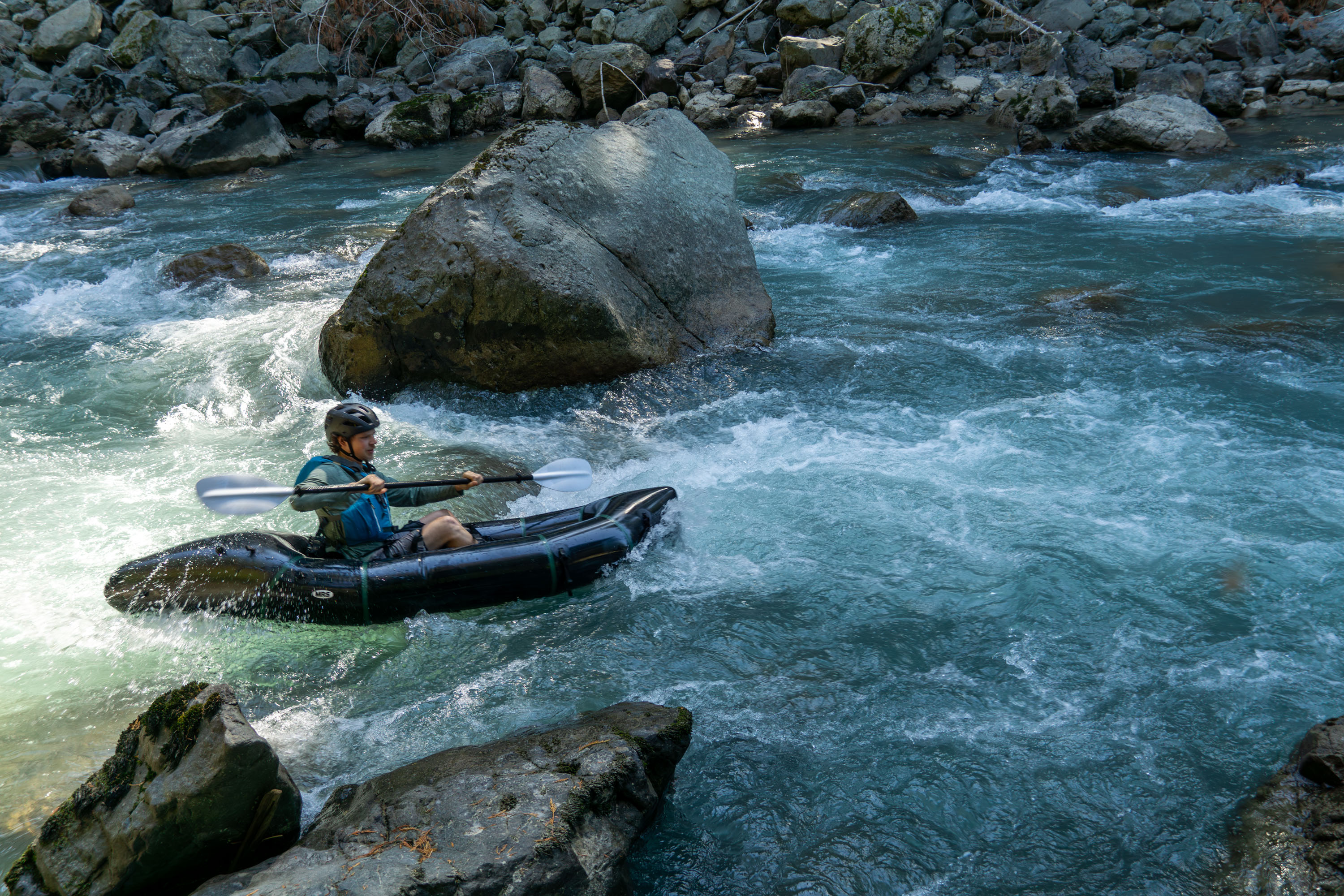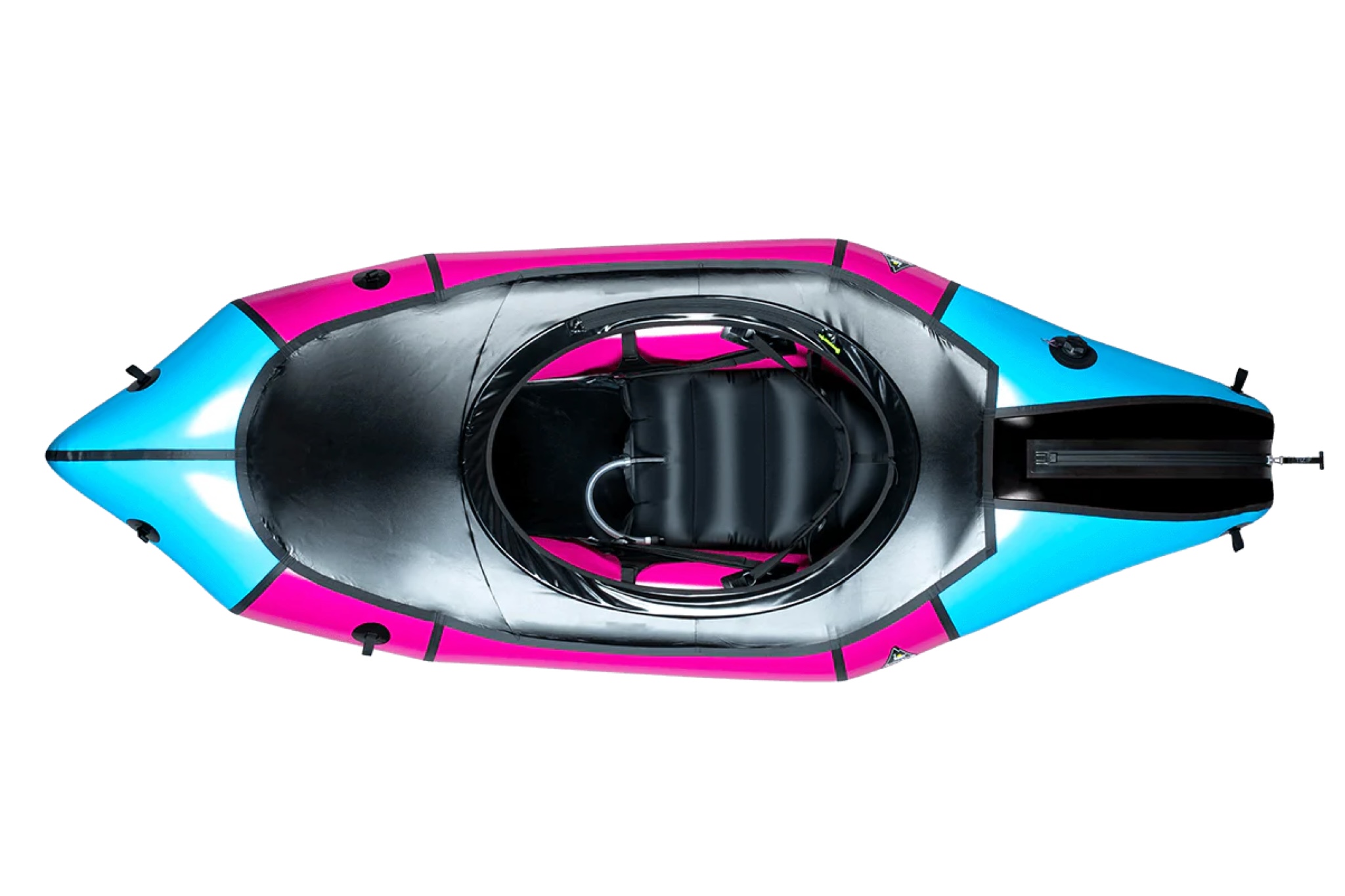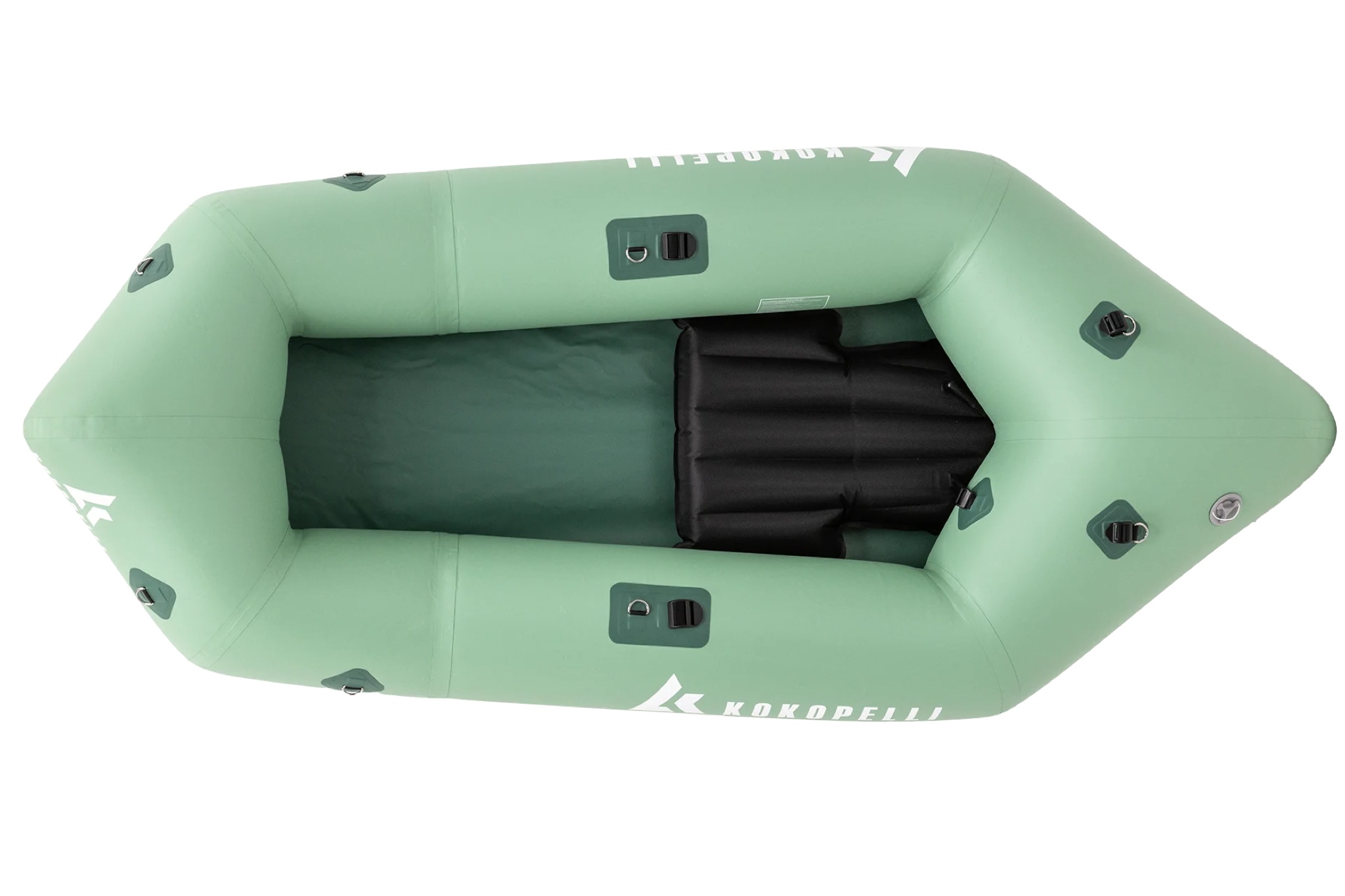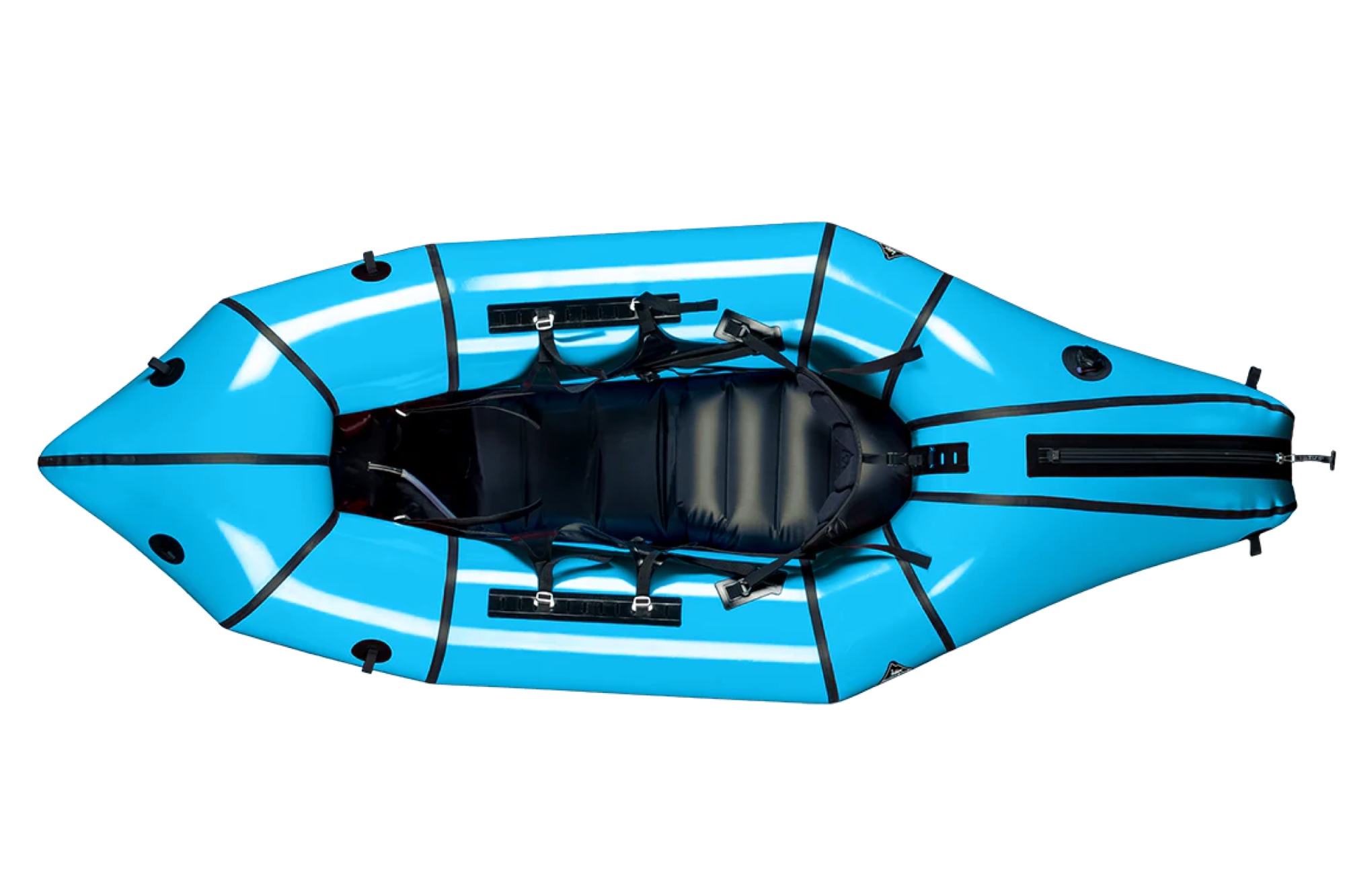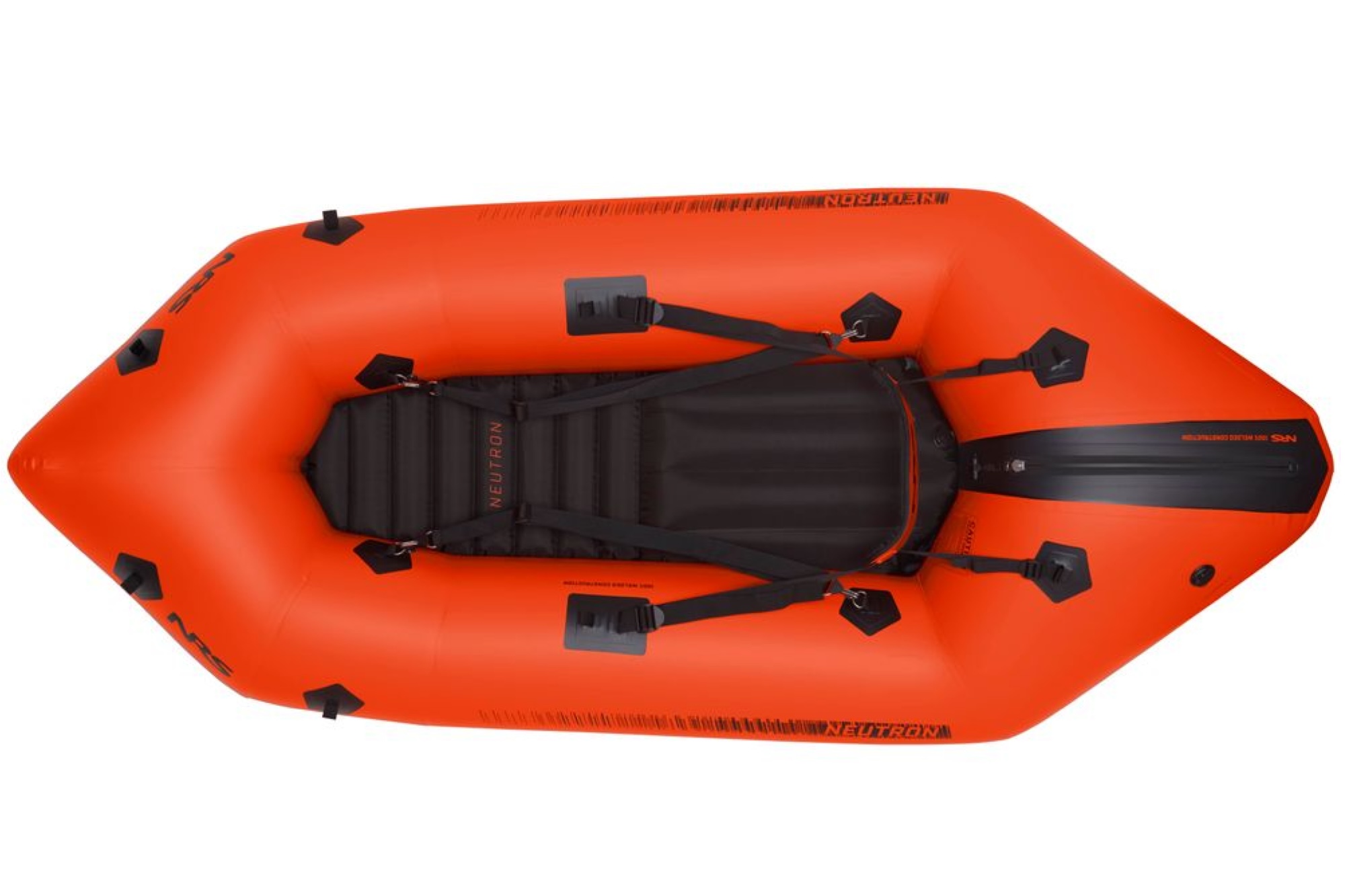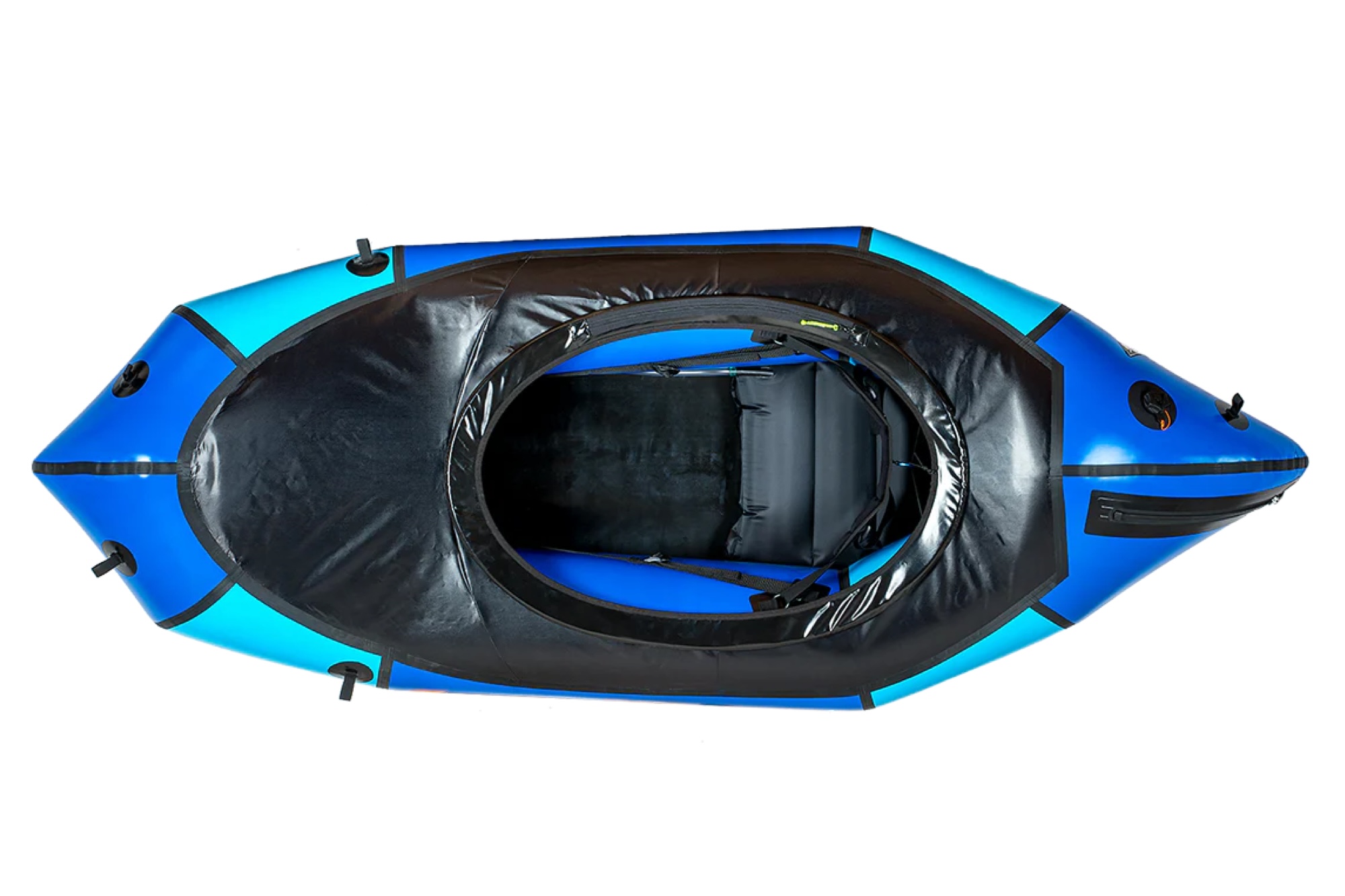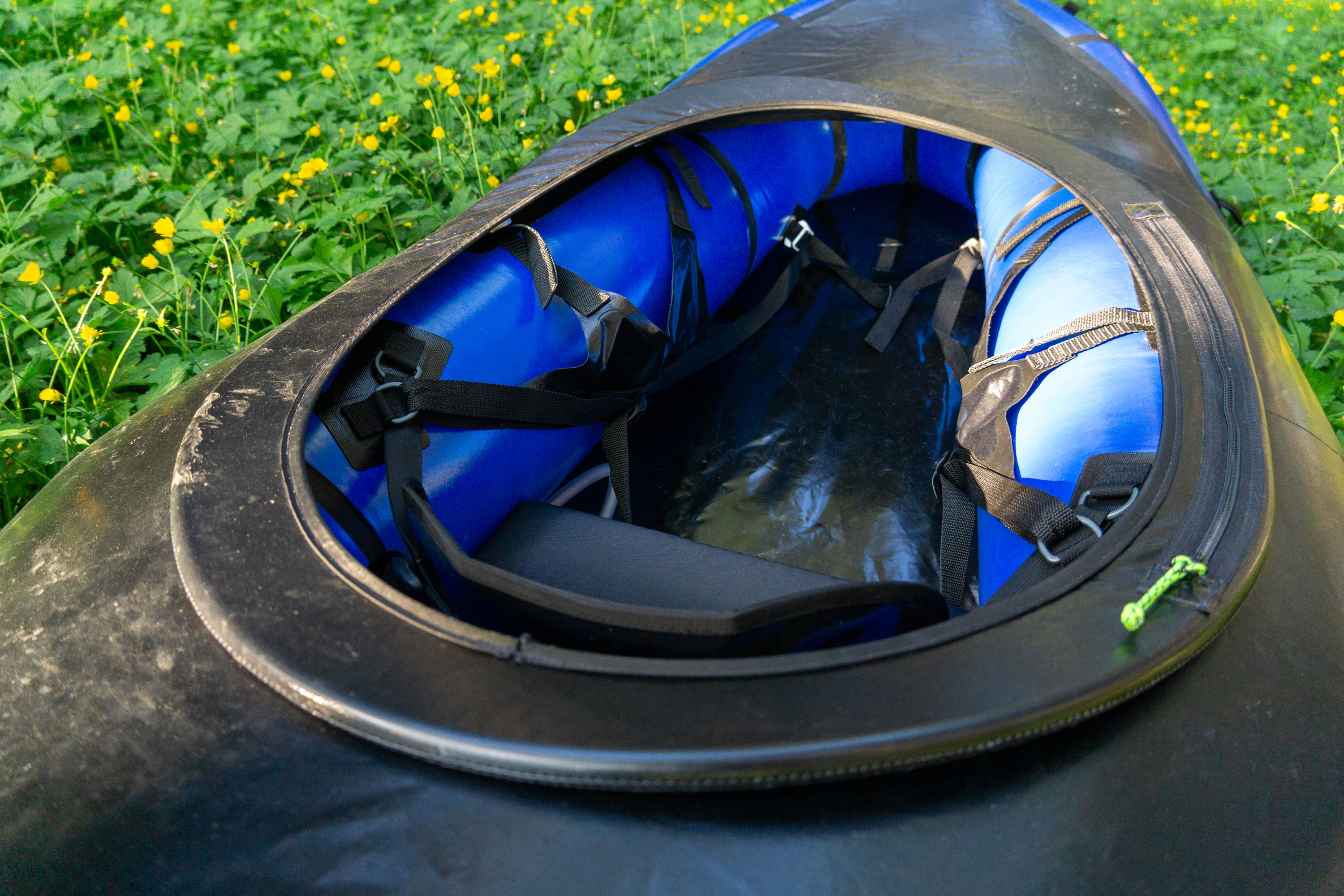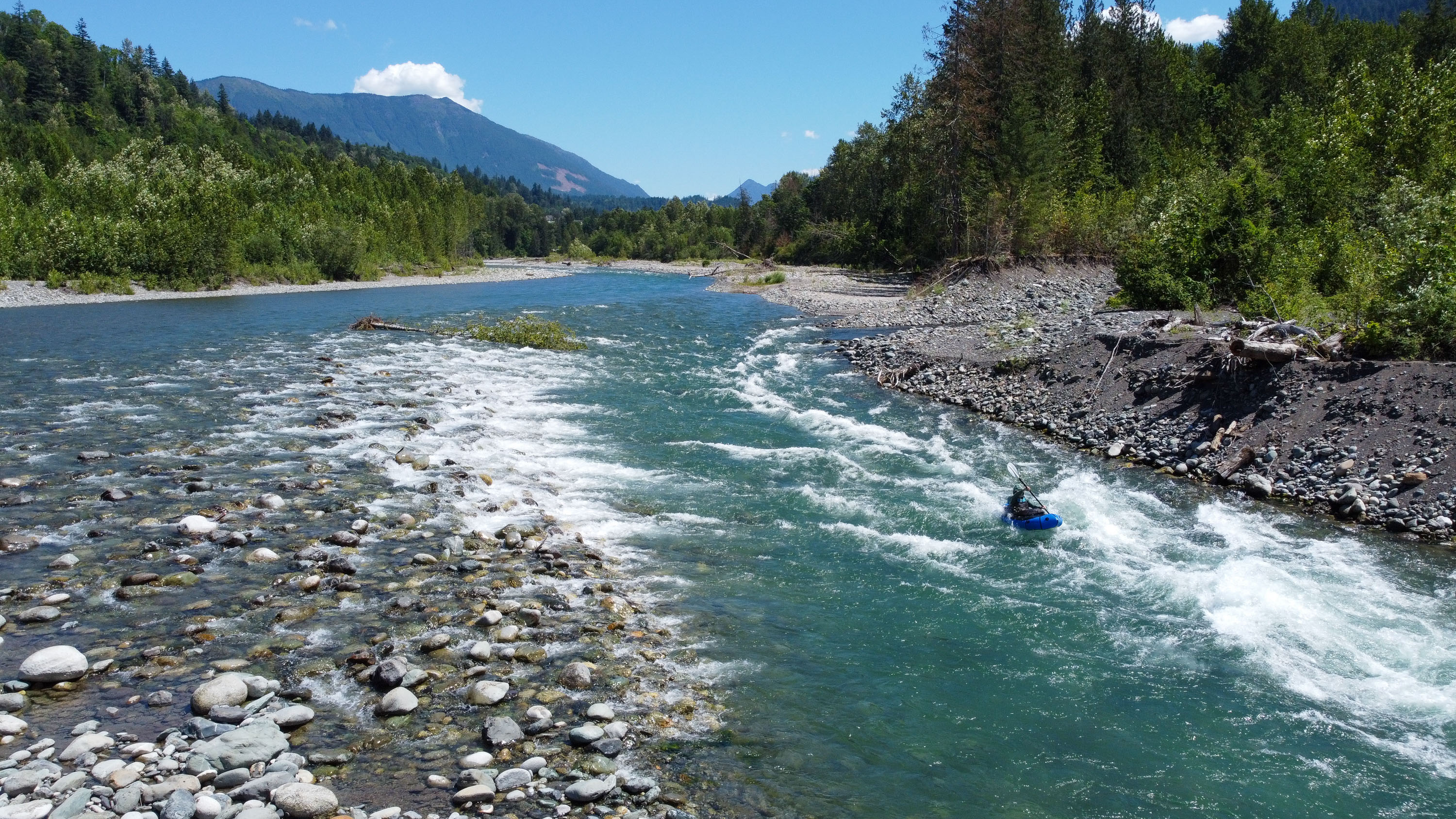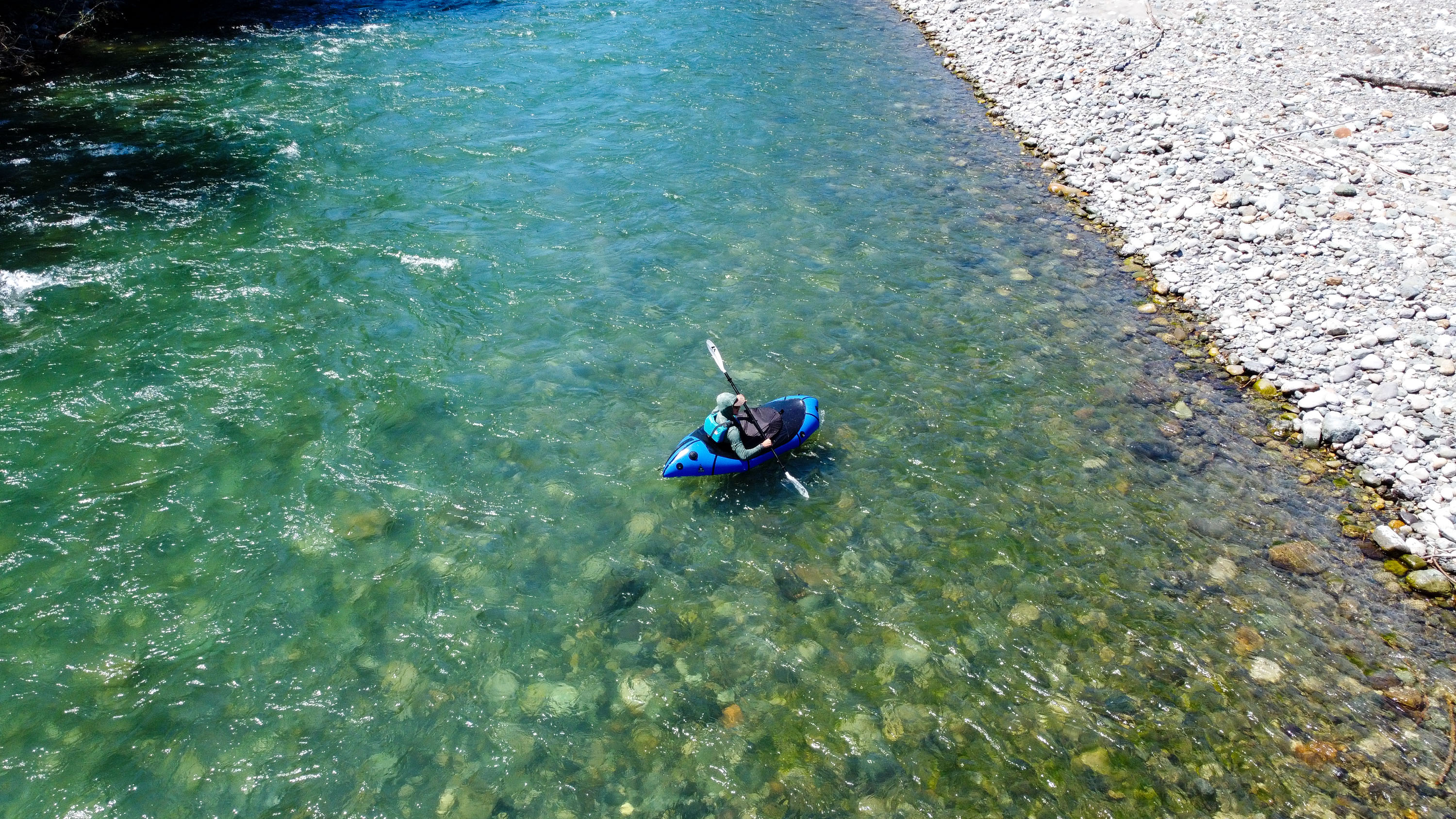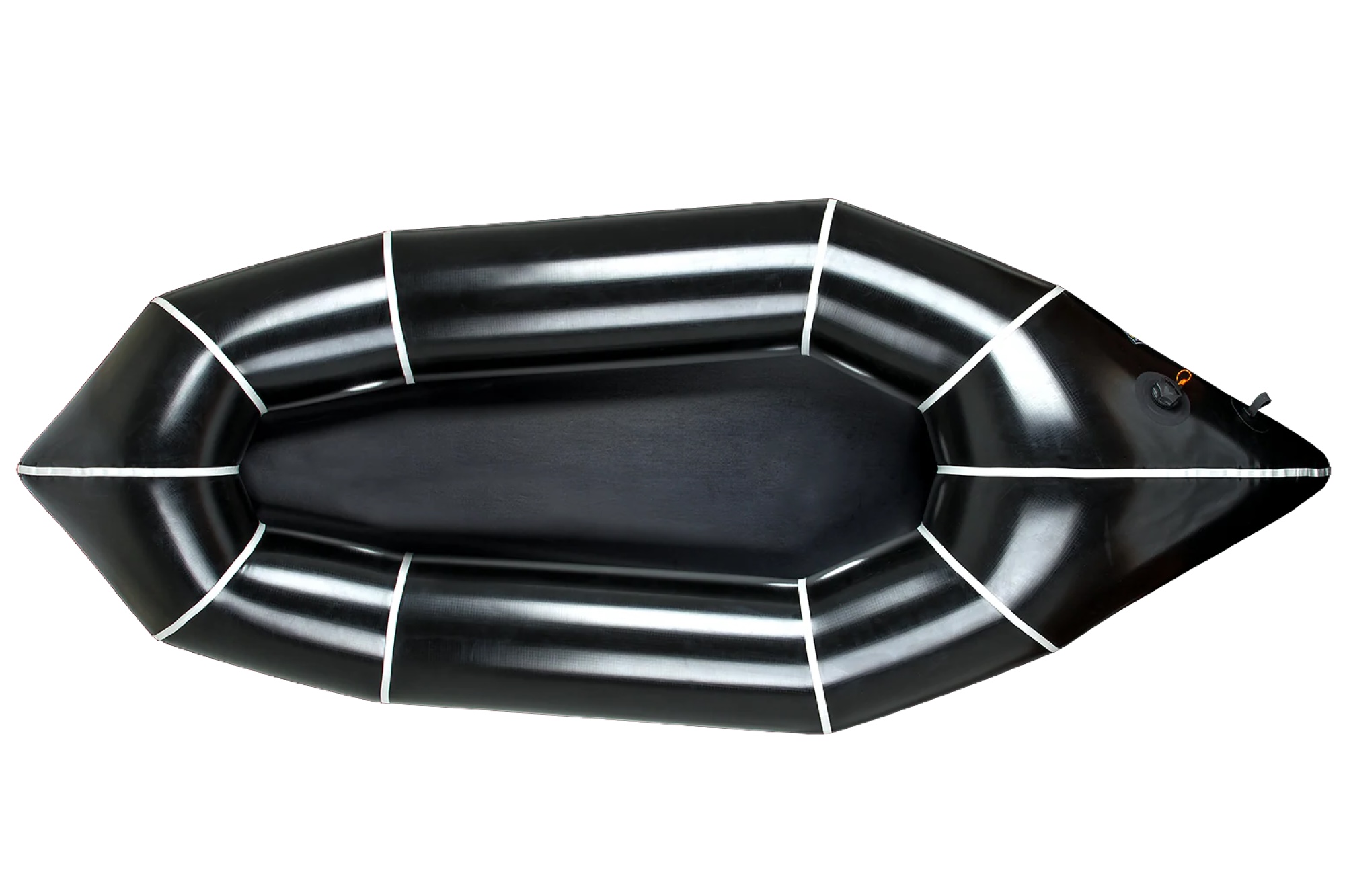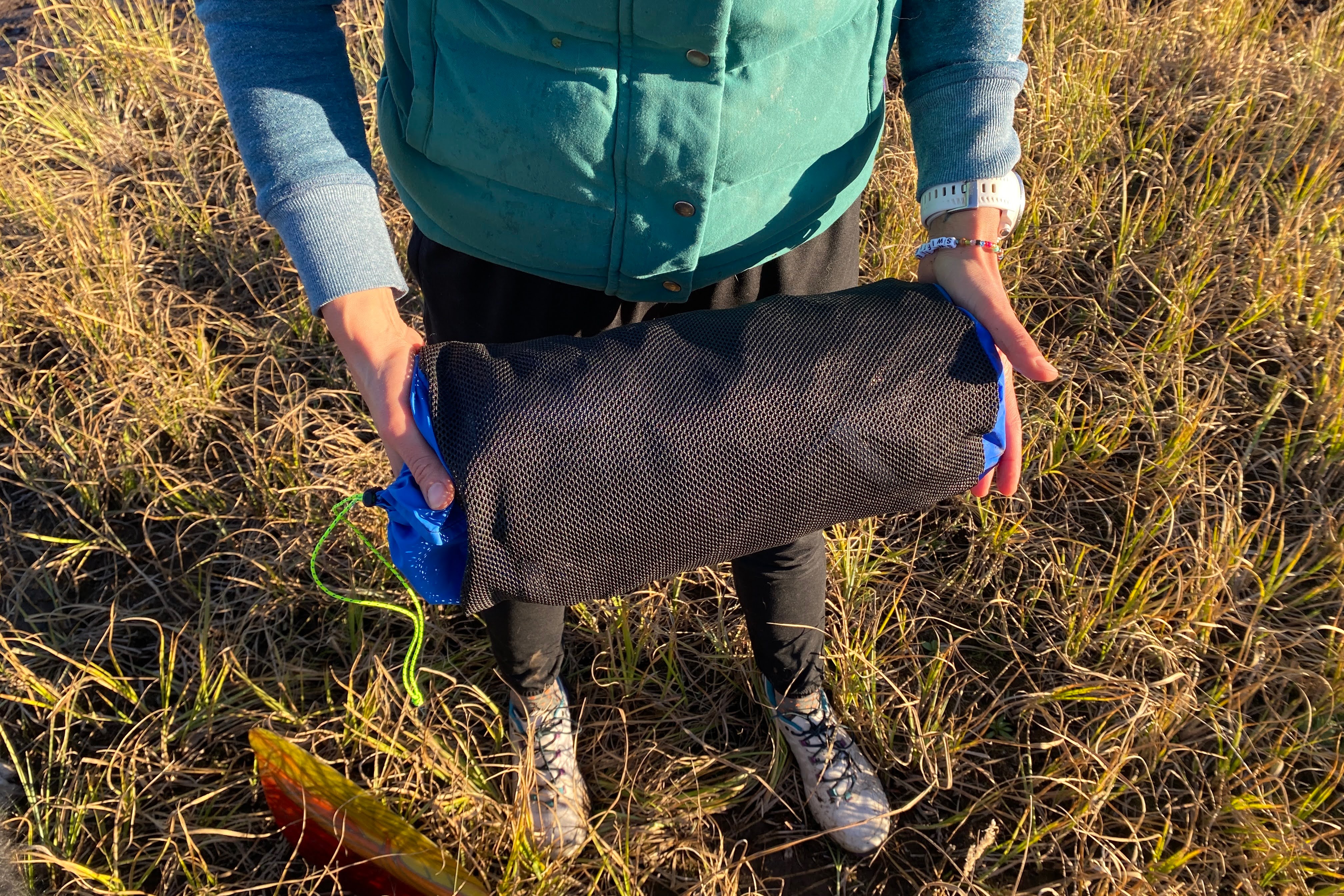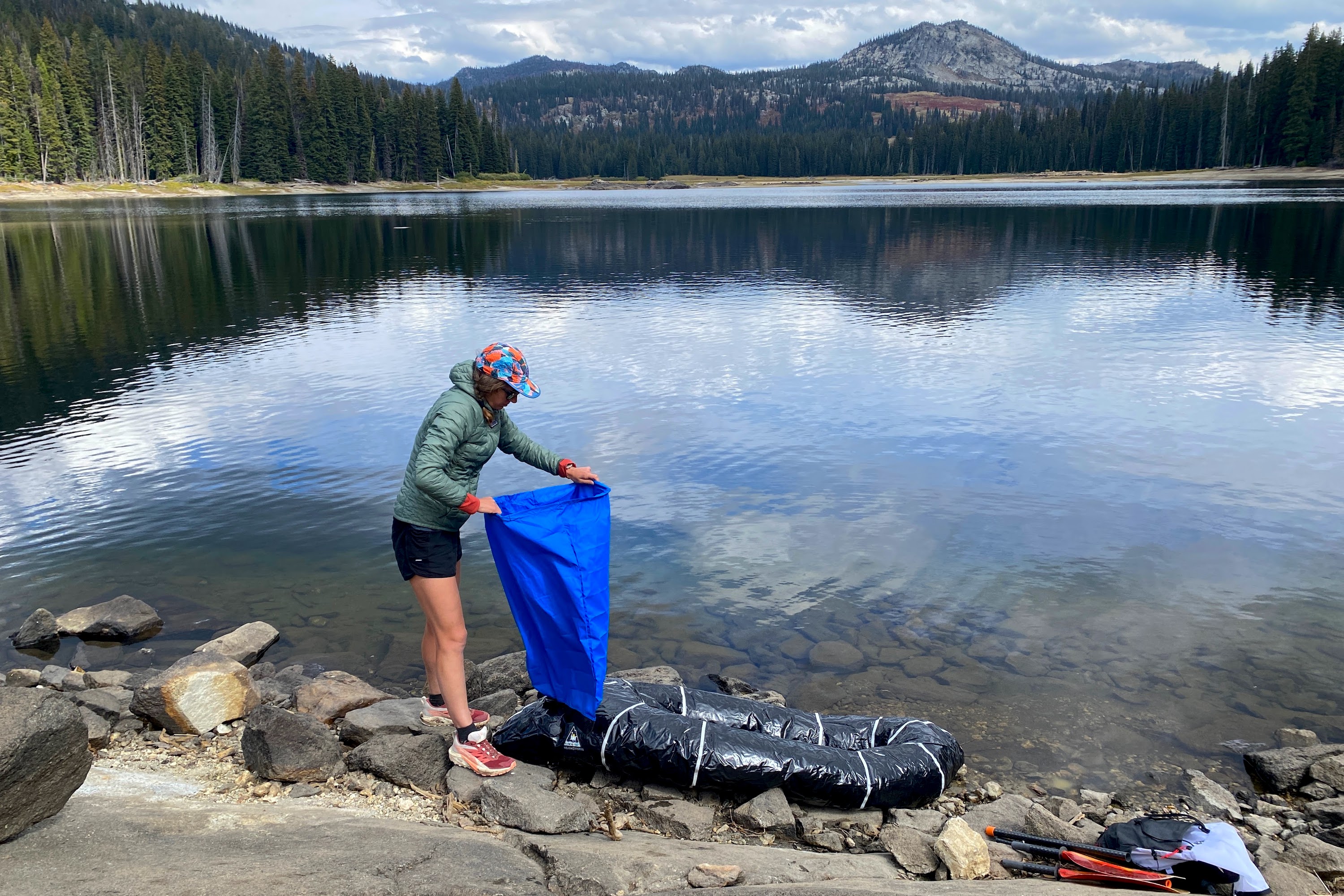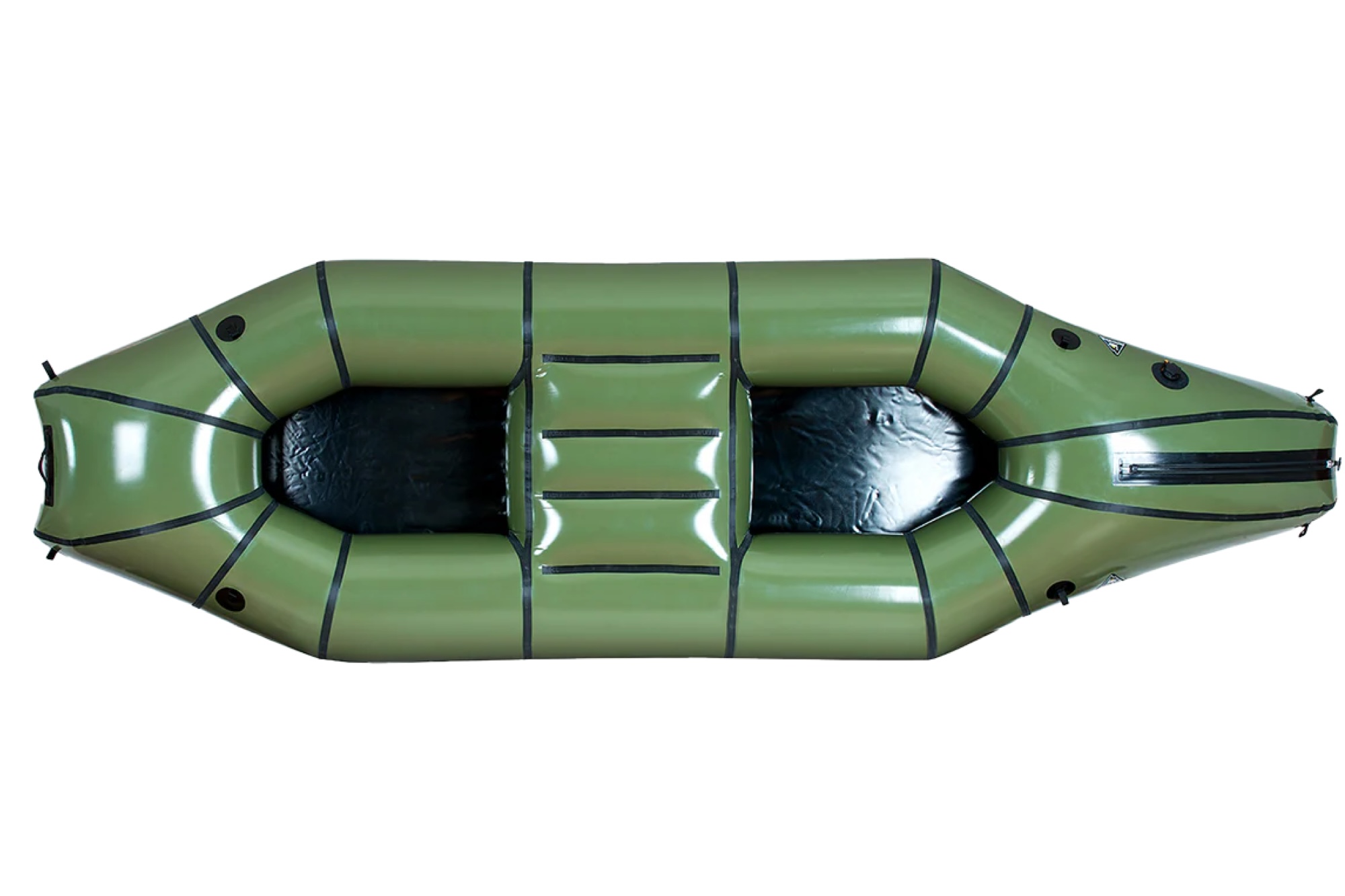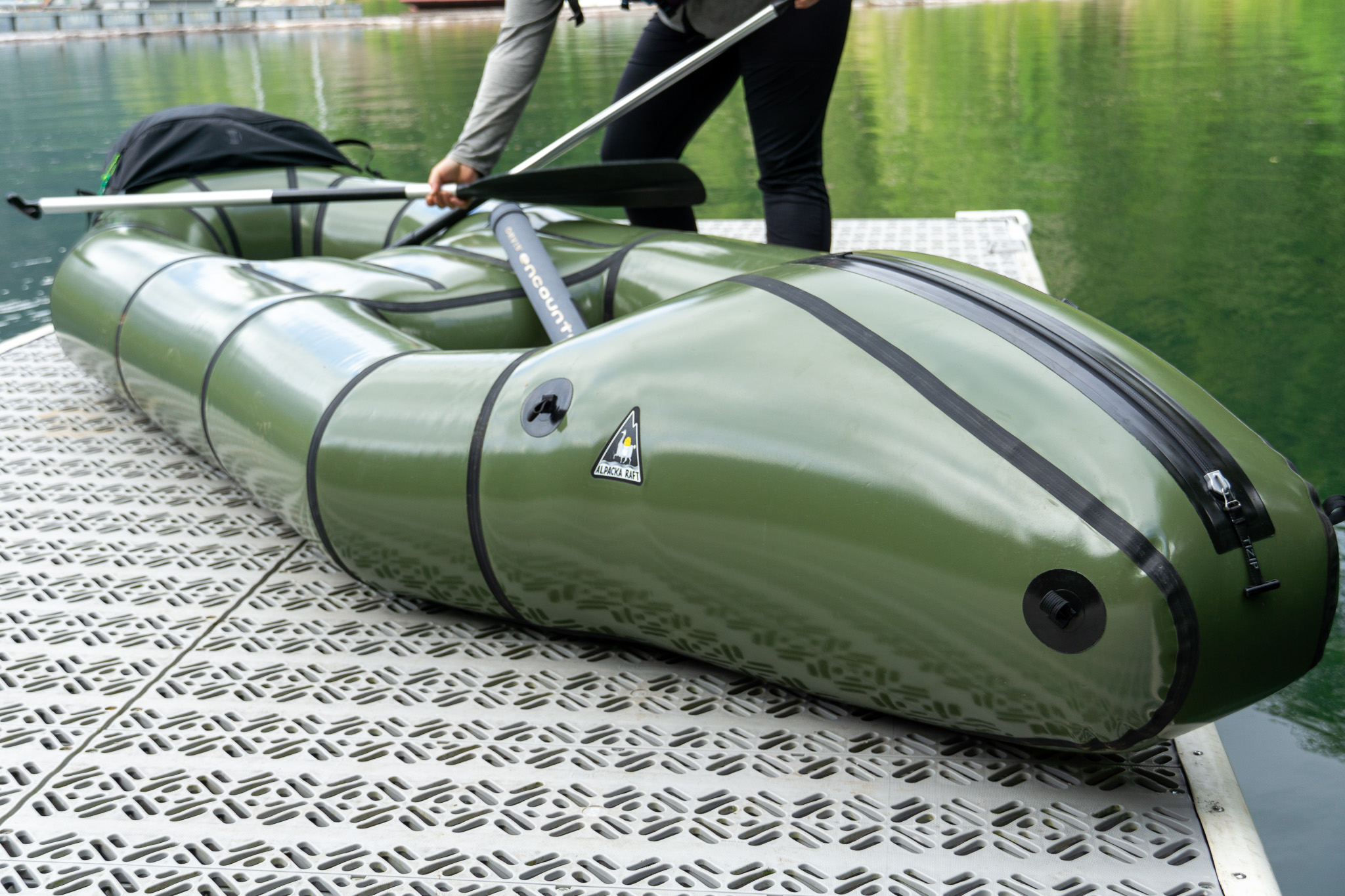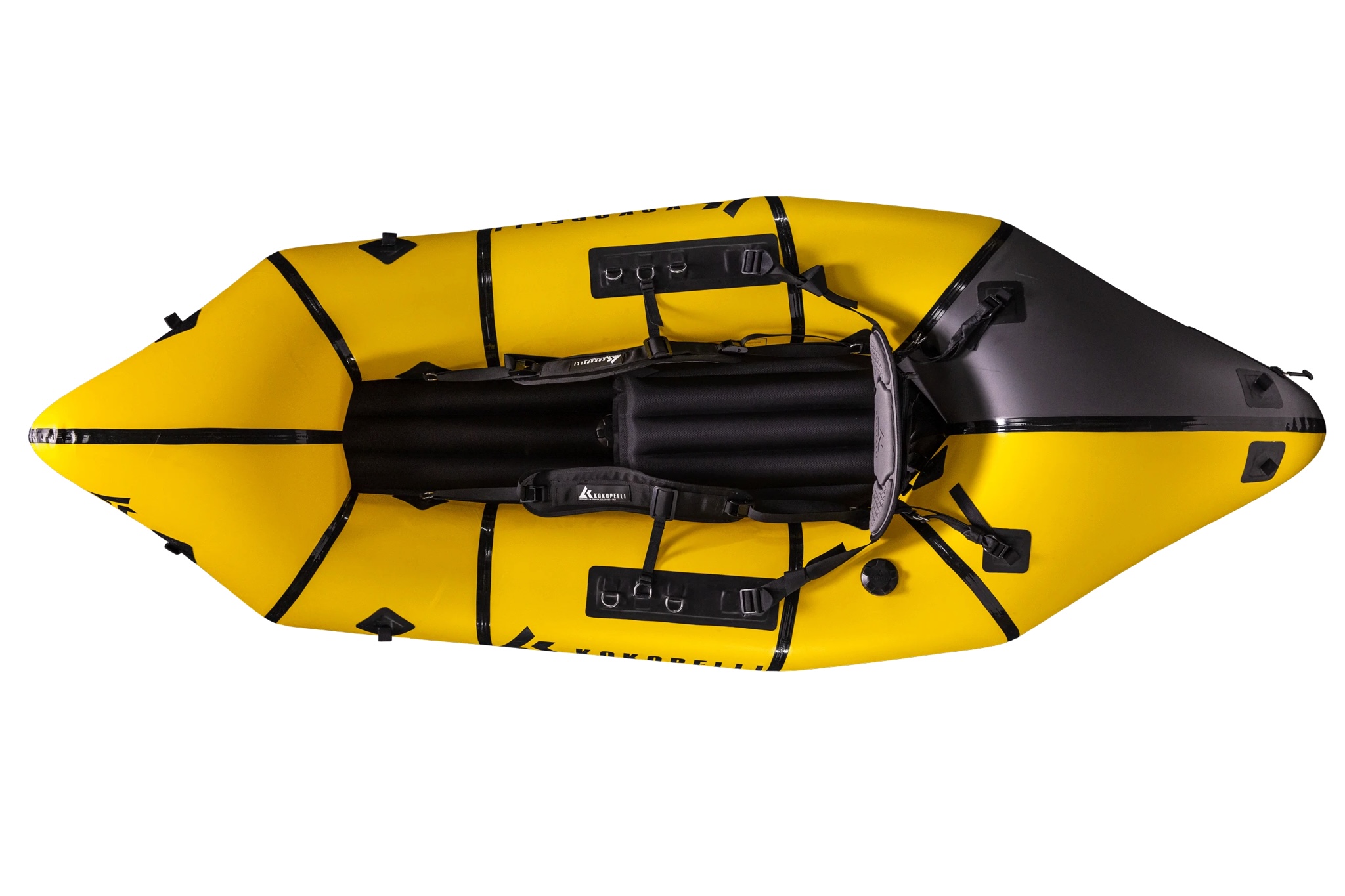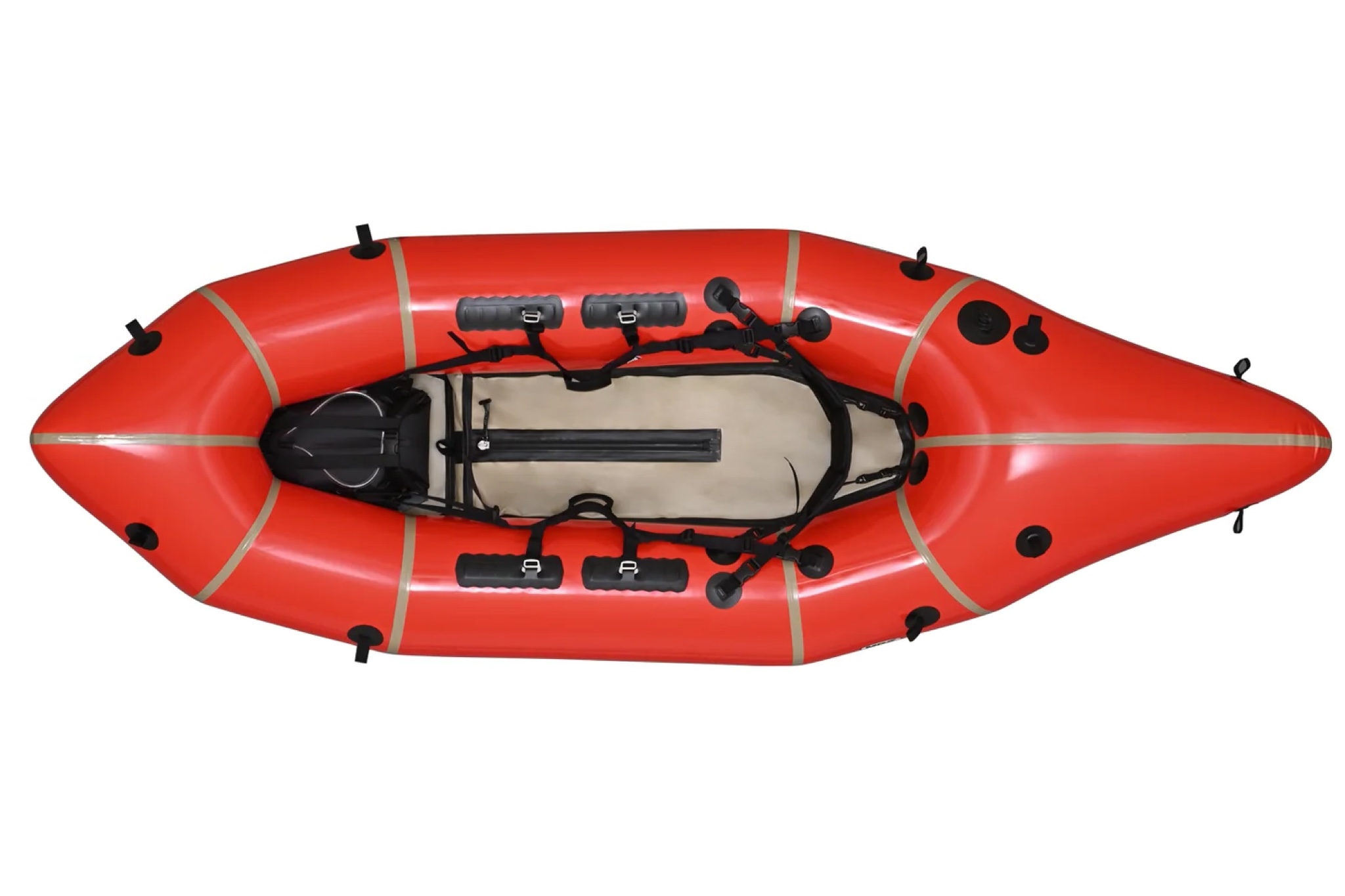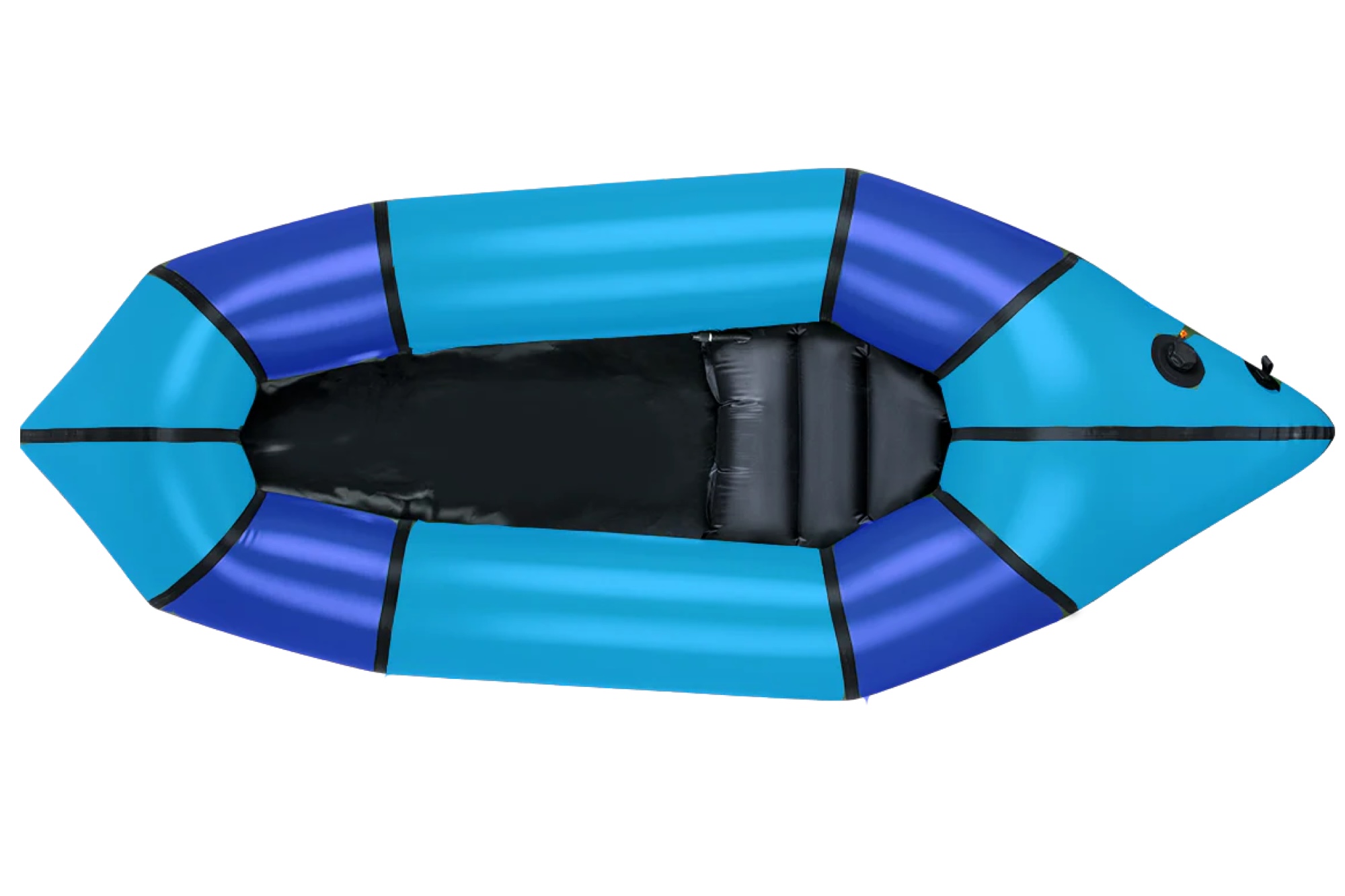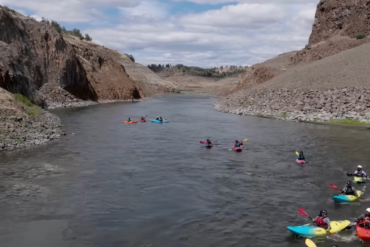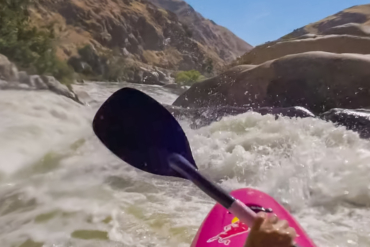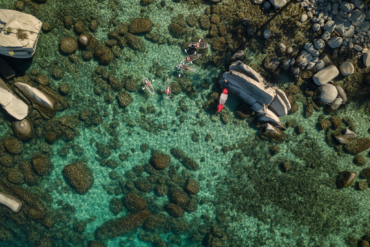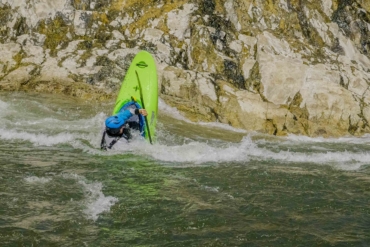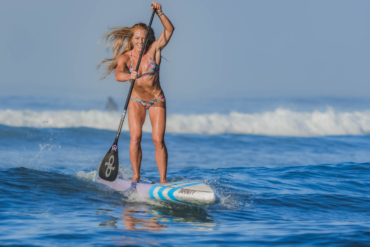A packraft, simply put, is an inflatable boat that you can roll up and put in your backpack to carry for significant distances. We’ve tested these lightweight watercraft since the early days and used them to ferry us deep into expeditions, and now more than 20 years down the line, we’ve found the best packrafts for any adventurer.
Packrafts now lean into all types of specialized use, from whitewater crushers that’ll keep up with hardshell kayaks to ultralight buckets to ferry you across a lake during an ultramarathon. We’ve tested them all, and paid special mind to ease of use, weight/packed size, durability, paddleability, and cost & value along the way.
If you’re after a do-it-all bruiser of a boat, we’re quick to recommend our top pick: the Alpacka Raft Expedition. Packrafts like these balance the issue well and will get you down some rough water while still packing well. Then there’s rugged (yet affordable) craft like the Kokopelli XPD — a boat that’ll last you years. We’ve pulled together these and many others, and think there’s a packraft for anyone here — no matter what you’re into.
Editor’s Note: We updated our Packraft guide on May 21, 2025, to add the newest raft from Kokopelli: the Rodeo. This whitewater rig has a fully inflatable I-beam floor that greatly stiffens it up and provides a good bit of 3D hull and rocker.
The Best Packrafts of 2025
Alpacka Raft Expedition
- Weight: 8 lbs., 3 oz. (with removable whitewater deck)
- Load Capacity: 350 lbs.
- Packed Size: 17 in. x 7.5 in.
- Water Rating: Class I – IV
- Material: Proprietary 210D high-count TPU nylon hull and 840D ballistic TPU nylon floor
- Tube Diameter: 10.6"
- Interior/Exterior Length: 43-49" / 91-97"
Pros
- Built to handle any water type
- Access to internal storage through the TiZip entry
- Spray deck standard
- Three sizes available for perfect fit
Cons
- Heavier than some
- Not available as a self-bailer
Kokopelli XPD
- Weight: 13 lbs.
- Load Capacity: 300 lbs.
- Packed Size: 24 in. x 10 in.
- Water Rating: Flat water, bays, inlets, Class I – II
- Material: 1000D reinforced PVC floor; 500D PVC tubes
- Tube Diameter: 12"
- Interior/Exterior Length: 47" / 84"
Pros
- Great for rivers and lakes
- Comes with most everything you need to paddle it
- Very durable and stable bucket design
- A new, even lower cost than previously
Cons
- Heavier weight limits packability
- Included pump is pretty low volume, and takes a while to inflate the boat
Alpacka Raft Gnarwhal
- Weight: 9 lbs., 3 oz. (size medium, whitewater deck)
- Load Capacity: 450 lbs.
- Packed Size: 20 in. x 9.5 in. (size medium, whitewater deck)
- Water Rating: Class I – IV
- Material: Proprietary 210D nylon hull and 840D ballistic nylon floor. 420D nylon hull is available as a heavy-duty option
- Tube Diameter: 11.7"
- Interior/Exterior Length: 43-49" / 94-100"
Pros
- Stable and forgiving
- Huge cargo capacity
- All-inclusive whitewater build
Cons
- Heavier
- Tends to give beginners a false sense of their abilities
NRS Neutron
- Weight: 11 lbs., 12.8 oz.
- Load capacity: 375 lbs.
- Packed size: 22 in. x 18 in.
- Water rating: N/A
- Material: 420D dual TPU coated nylon hull and 840D nylon floor
- Tube diameter: 12 in.
- Interior/Exterior length: 53 in. / 90 in.
Pros
- Super-tough double TPU-coated nylon material
- Full-length floor
- TiZip is well placed for splitting the boat and getting gear inside
- Large tubes provide a planted feel
Cons
- Not the lightest or most packable design
- Valve cap tether can interfere with valve underneath it
- Thigh straps aren't the easiest to adjust
Alpacka Raft Refuge
- Weight: 6 lbs., 11.2 oz.
- Load Capacity: 250 lbs.
- Packed Size: 15" x 7"
- Water Rating: Class I-III
- Material: Proprietary lightweight 210D nylon hull and 840D nylon floor
- Tube Diameter: 10"
- Interior/Exterior Length: 46.5-49.5" / 87-89.5"
Pros
- Impressive whitewater ability in a small package
- Full-featured with a TiZip, thigh straps, and whitewater deck
- Tough 840D floor material resists bumps and bruises
- Shorter length turns on a dime
Cons
- A little small for a full expedition boat
- Thigh strap tag ends can become snagged when entering
- Lower load capacity
Alpacka Raft Ghost
- Weight: 2 lbs., 4 oz.
- Load Capacity: 225 lbs.
- Packed Size: 11 in. x 5 in.
- Water Rating: Flat water, mountain lakes, simple river crossings
- Material: Proprietary ultralight 70D nylon hull and 200D nylon floor
- Tube Diameter: 10"
- Interior/Exterior Length: 44" / 84"
Pros
- Incredible lightweight and packable size
- Maintains a proven raft design
- No cheap valves here, comes standard with Alpacka’s temper assist valve
Cons
- Long-term durability won’t be all there
- Load capacity is fairly low
Alpacka Raft Rendezvous
- Weight: 10 lbs.
- Load Capacity: 800 lbs.
- Packed Size: 20 in. x 9 in.
- Water Rating: Class I – III
- Material: 210-denier nylon hull and 840-denier ballistic nylon floor
- Tube Diameter: 13 in.
- Interior/exterior Length: 74.5 in. / 132 in.
Pros
- Massive load capacity
- Integrated seat adds rigidity to the boat
- Can stand on the floor to scout or fish
- Cargo fly can hold an impressive amount of kit
Cons
- Not as capable in whitewater as some other tandem rafts
- Higher sitting platform means greater windage
- Stern could use an integrated handle
Other Packrafts We’ve Paddled
The seven packrafts above are bar-none our go-to fleet of capable watercraft for a variety of conditions and water, but there’s still plenty out there that will get the job done. Below are six additional packrafts that we’ve paddled extensively and can still wholeheartedly recommend. They might not be the perfect solution, but packrafting was never about being perfect — just dang close.
- Weight: 12 lbs., 9.6 oz.
- Load Capacity: 300 lbs.
- Packed Size: 25 in. x 8 in.
- Water Rating: Class I – IV+
- Material: 210D TPU nylon + Kevlar hull and 840D TPU nylon + Kevlar floor
- Tube Diameter: 10.6"
- Interior/Exterior Length: 47" / 96"
Pros
- Very quick to lean on edge
- Thigh straps are quite responsive
- Rugged Kevlar-reinforced tube and floor material
- TiZip internal storage is standard
Cons
- A bit larger packed size and weight compared to other similar rafts
- Price is up there
- No option for a whitewater decked model
- Weight: 11 lbs., 10.2 oz.
- Load Capacity: 330 lbs.
- Packed Size: 24 in. x 6 in.
- Water Rating: Class II-III
- Material: 420D TPU nylon hull, and 840D TPU nylon floor
- Tube Diameter: 11.4"
- Interior/Exterior Length: 54" / 106"
Pros
- Directional baffles in floor makes for quick maneuverability
- Two-part seat with foot well is excellent to brace against
- Burly 840D floor material
Cons
- Drainage isn't the fastest
- Only one size available
- Weight: 3 lbs., 13 oz.
- Load Capacity: 400 lbs.
- Packed Size: 15 in. x 5 in.
- Water Rating: Ideal for quick water crossings, flat water
- Material: Nylon Oxford TPU laminate
- Tube Diameter: 9 in.
- Interior/Exterior Length: 62 in. / 72 in.
Pros
- Super-fast inflation time
- Packs down the size of a loaf of bread
- Can store kit inside the tubes
- Great for ferrying gear across a river
Cons
- Roll closure can slowly leak air
- No seat means a cold butt
- Weight: 8 lbs., 11.2 oz.
- Load Capacity: 300 lbs.
- Packed Size: 16" x 8"
- Water Rating: Flat water, lakes, Class I
- Material: 210D TPU nylon hull, and 840D TPU nylon floor
- Tube Diameter: 12"
- Interior/Exterior Length: 61.5" / 110.5"
Pros
- Excellent tracking bow and stern profiles
- Tougher 840D floor doesn't mind carrying bikes or pups
- Removable fin improves tracking in flat water
- Improved stability from longer profile
Cons
- Heavier than similar Alpacka Mule, and less weight capacity
- Weight: 9 lbs., 1 oz.
- Load Capacity: 300 lbs.
- Packed Size: 16 in. x 8 in.
- Water Rating: Flat water, bays, inlets, Class I – II
- Material: 210D TPU hull, and 210D TPU + DuPont Kevlar Aramid-nylon blend floor
- Tube Diameter: 12"
- Interior/Exterior Length: 57" / 90"
Pros
- Removable spraydeck means maximum flexibility
- Tough Kevlar floor material
- Optional TiZip internal storage
Cons
- Packed size is larger than advertised
- Heavier than other boats of the same use-profile
- Weight: 3 lbs., 12.8 oz.
- Load capacity: 250 lbs.
- Packed size: 12" x 6.25"
- Water rating: Flat water, alpine lakes, quick river crossings
- Material: Proprietary lightweight 210D nylon hull and 420D nylon floor
- Tube diameter: 10"
- Interior/Exterior length: 46" / 86"
Pros
- Great maneuverability
- Quick inflation
- Lightweight
- TiZip available
Cons
- Few lash points
- Small size
- Slower paddling than some designs
Packrafts Comparison Chart
| Packraft | Price | Weight | Load Capacity | Packed Size | Material |
|---|---|---|---|---|---|
| Alpacka Raft Expedition | $1,500 | 8 lbs., 3 oz. | 350 lbs. | 17 in. x 7.5 in. | Proprietary 210D high-count nylon hull and 840D ballistic nylon floor |
| Kokopelli XPD | $699 | 13 lbs. | 300 lbs. | 24 in. x 10 in. | 1000D reinforced PVC floor and 500D PVC hull |
| Alpacka Raft Gnarwhal | $1,525 | 9 lbs., 3 oz. | 450 lbs. | 20 in. x 9.5 in. | Proprietary 210D nylon hull and 840D ballistic nylon floor |
| NRS Neutron | $1,145 | 11 lbs., 12.8 oz. | 375 lbs. | 22 in. x 18 in. | 420D dual TPU coated nylon hull and 840D nylon floor |
| Alpacka Raft Refuge | $1,250 | 6.7 lbs. | 250 lbs. | 15 in. x 8 in. | Proprietary lightweight 210D nylon hull and 840D nylon floor |
| Alpacka Raft Ghost | $750 | 2 lbs., 4 oz. | 225 lbs. | 11 in. x 5 in. | Proprietary ultralight 70D nylon hull and 200D nylon floor |
| Alpacka Raft Rendezvous | $1,700 | 10 lbs. | 800 lbs. | 20 in. x 9 in. | 210-denier nylon hull and 840-denier ballistic nylon floor |
| Kokopelli Rodeo | $1,999 | 12 lbs., 9.6 oz. | 300 lbs. | 25 in. x 8 in. | Nylon Oxford TPU laminate |
| MRS Viking Self Bailer | $1,249 | 11 lbs., 10.2 oz. | 330 lbs. | 24 in. x 6 in. | 420D TPU nylon hull, and 840D TPU nylon floor |
| Uncharted Supply Co. Rapid Raft | $479 | 3 lbs., 13 oz. | 400 lbs. | 15 in. x 5 in. | Nylon oxford TPU laminate |
| Kokopelli Twain Lite | $1,099 | 8 lbs., 11.2 oz. | 300 lbs. | 16 in. x 8 in. | 210D TPU and nylon hull, and 840D TPU and nylon floor |
| Kokopelli Rogue R-Deck | $1,199 | 9 lbs., 1 oz. | 300 lbs. | 16 in. x 8 in. | 210D TPU hull, and 210D TPU + DuPont Kevlar Aramid-nylon blend floor |
| Alpacka Raft Scout | $775 | 3 lbs., 12.8 oz. | 250 lbs. | 12 in. x 6.25 in. | Proprietary lightweight 210D nylon hull and 420D nylon floor |
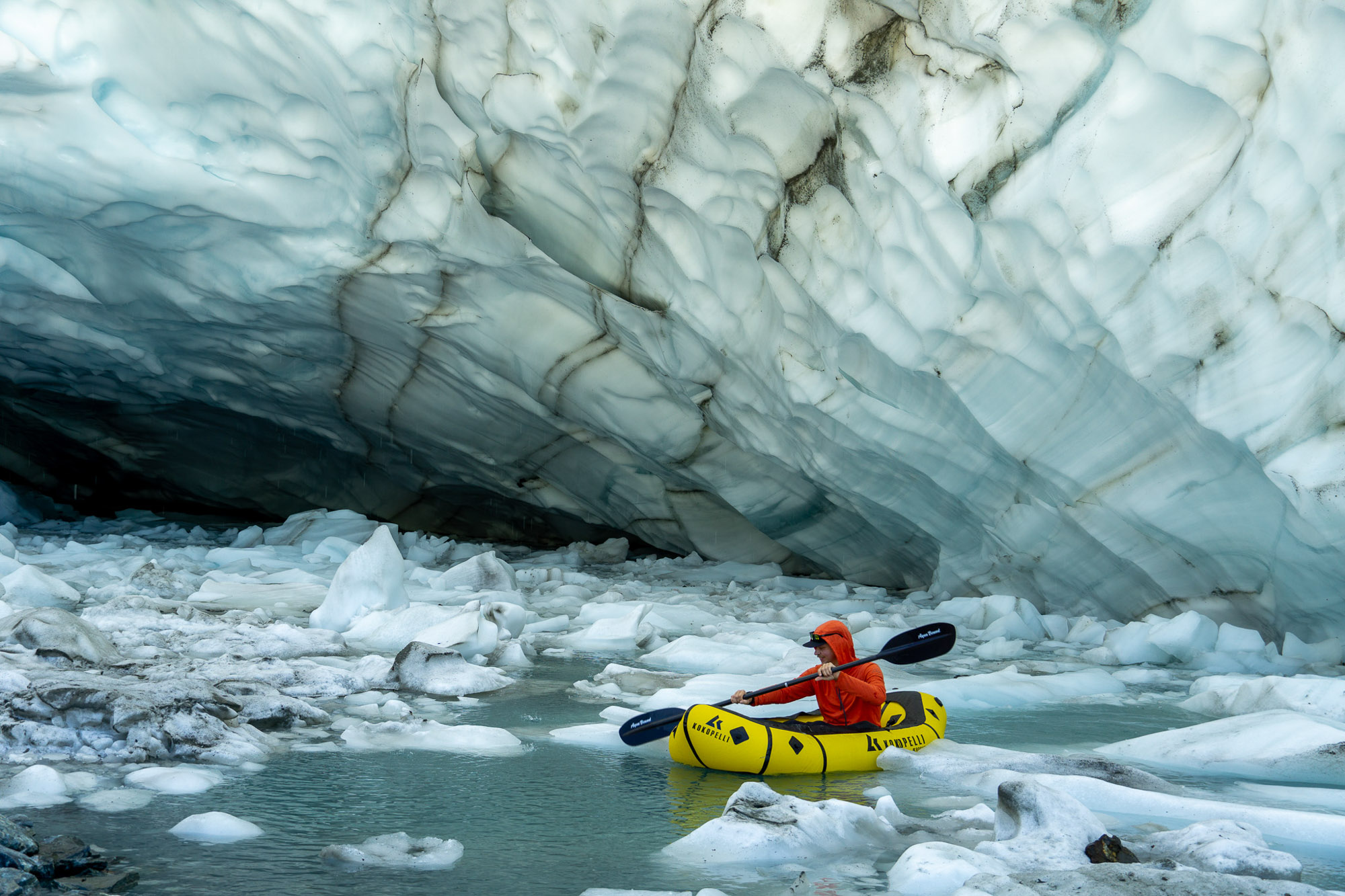
How We Tested the Best Packrafts
Our Expert Testers
GearJunkie is lucky to play host to a number of packrafters — from the packraft-curious to paddling fiends. Two such experts are Chelsey and Jason Magness, who completed an early descent of the now-classic Little Nahanni River to access the Cirque of the Unclimbables in 2005.
The ensuing expedition also became the first ascent of Lotus Flower Tower without using air to access the Cirque, and the possibilities of using packrafts to access deep locales opened up. Since that first introduction, packrafting has changed our relationship with the outdoors more profoundly than many other pieces of gear.
Leading our packraft testing today is Senior Editor Nick Belcaster, a late-blooming water baby who took up packrafting 3 years ago and hasn’t stopped since. In that time, he’s paddled rough water across Washington State and British Columbia, as well as used packrafts on a few traverses and deep expeditions.

Our Testing Process and Testing Grounds
In order to test a boat’s mettle, we paddled them in all kinds of conditions and water types — from rucking them into high alpine lakes to running swollen Class II-IV rivers. A packraft is as much about paddling ability as it is about portability, so we paid equal measure in our consideration to packability and weight as we did how it managed on the water.
Our testing grounds ranged from mellow Class I lakes and creeks to Class IV, and our tested packrafts cover the spread, as we understand that everyone has different priorities. We tested how well bikepacking rafts carried bikes, how small emergency rafts packed down, and how much we could feasibly cram into tubes for storage. Material choice was evaluated, as were small details such as the choice of valves, or the placement of tie-offs, and the way seams were sealed.
With packrafting still growing as a sport, we’ll continue to inflate the best-of-the-best and add them here if we think they’ve made the cut. If you’re looking to paddle something with a bit more structure, check out our Best Kayak or Paddleboard Buyer’s Guides.

Buyer’s Guide: How to Choose a Packraft
What Is Packrafting?
Simply put, a packraft is an inflatable boat that you can roll up and put in your backpack. These boats usually weigh about 5-10 pounds, only take up a portion of the space in your pack, and are usually inflated with a minimalist “inflation bag” instead of a pump.
Most notably, packrafts are durable enough to survive some level of rugged and remote usage where equipment failure is less of an option. They are much more durable than the similarly shaped vinyl boats or pool toys that are widely and cheaply available at big-box stores.
Like other watercraft, packrafts are also designed to be either generalists or specialists in their respective uses — from big whitewater boats to plunk-around and paddle crafts — and a number of different levers can be pulled in fine-tuning a boat, from tube size to material thickness to bow and stern shape. Choosing which packraft is right for you will require some consideration of exactly how you want to use it.

Packraft User Profiles
The Casual Paddler: For the packrafter looking for a little of everything, finding an even-keeled boat is all about balancing ability and packability. Typical tube material denier lands around 210-420, with floors often being a thicker 840D.
Most material will be TPU, which packs down smaller than the PVC used on cheaper boats. Finally, look for a boat that offers the adaptability you’ll want for different types of paddling. Whitewater decks can be ordered as removable, which is a huge plus for easy lazy-river drifting.
The Kokopelli Rogue R-Deck is an inflatable Swiss Army knife, amenable to everything from flat water cruising to dipping your toes into Class I and II white water when you’re ready to crank the dial a bit. And if the Rogue is a multitool, then the Alpacka Raft Expedition is a hammer — capable of throwing down in turbulent water and being saddled up with a load of kit.
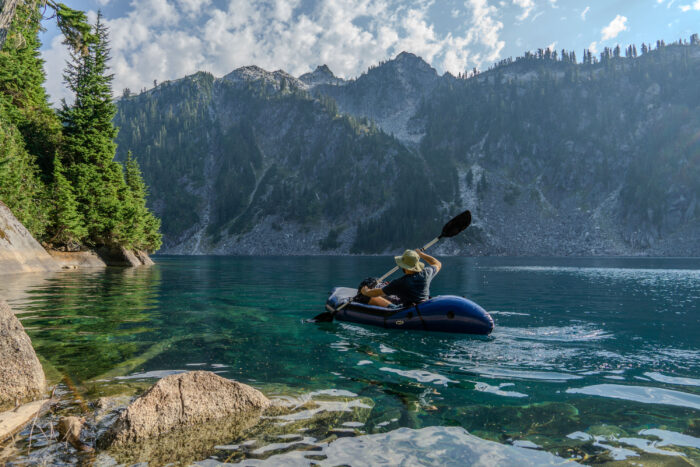
The Whitewater Hound: Time to get rowdy. Paddling a packraft through heavy water can be an absolute hoot, but you’ll need a rig that can stand up to the abuse. For those looking to get pitted, consider the spray-decked and self-bailing options available. The former will provide a drier and warmer ride when paired with a whitewater skirt, while the latter is much easier to jump in and out of.
You’ll also want to ensure your ride has a solid set of thigh straps installed, which gives you much more leverage over your boat in unsteady water. Finally, aim for a more rockered bow with larger (11″+) tubes that help your packraft punch through holes.
When the time comes to ride some whitewater, we almost always reach for the high-volume Alpacka Raft Gnarwhal — a raft that seems to levitate over deep holes and sucking backwaters. For adventures that are further afield, the Alpacka Raft Expedition tightens the belt a bit to save a pound without sacrificing much ability. And if warm water or frequent portages are on the menu, a self-bailer like the Kokopelli Rodeo makes things easy.
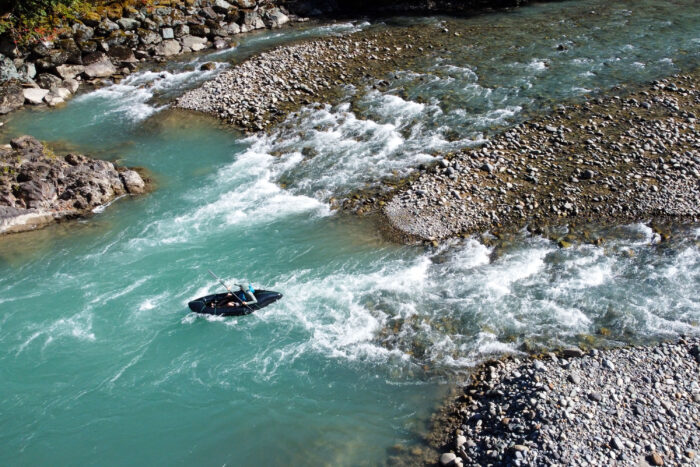
The Backcountry Hunter and Fisher: When a fully dressed moose can weigh north of 500 pounds, you’re going to need the big rig of the packrafting world to ruck it out. Packrafts have been used successfully in deep backcountry hunts for years, and anyone aiming to bring one along should look for a boat that has max loaded capacity above whatever you’re looking to pack out (plus yourself).
A 400-pound limit will typically carry smaller game like deer and sheep, while a 500- to 750-pound limit will carry larger game like caribou and elk. The Alpacka Raft Forager is the ultimate in big-game packrafting, while the Alpacka Raft Mule and Caribou offer a mid-size and ultralight option to fill out your quiver.
Anglers, on the other hand, don’t need as much space to pack out their quarry, and should instead aim for a raft that’s both burly and lightweight and provides extra space for storing tackle and rods. For stalking fish around lowland lakes and rivers, the 1,000D PVC of the Kokopelli XPD shrugs off errant hooksets, and the Kokopelli Twain Lite offers up an extended bow for extra storage. For high-alpine endeavors, opt for a lightweight boat such as the ~4-pound Uncharted Supply Co Rapid Raft or even more packable Alpacka Raft Scout.
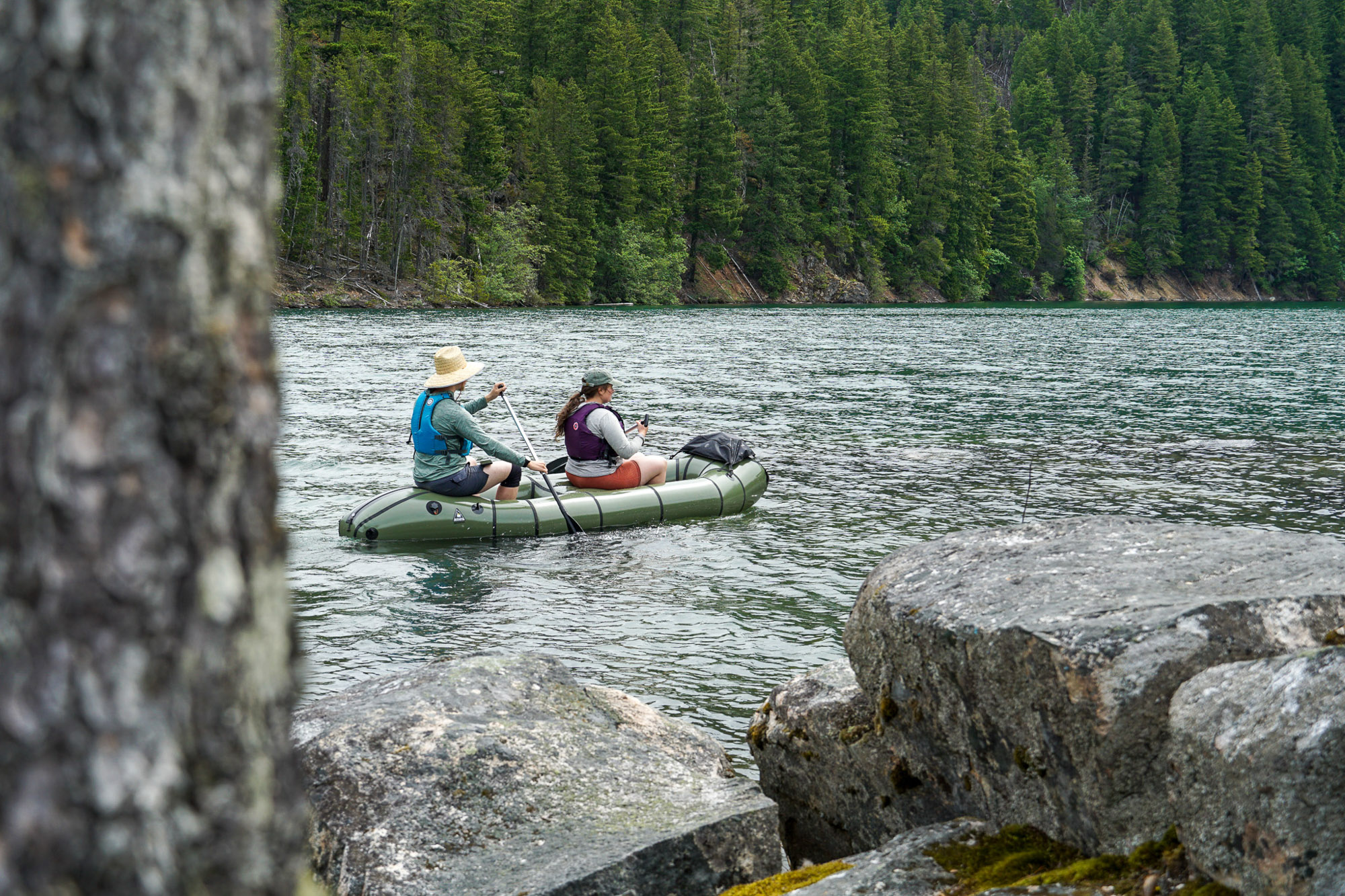
The Long-Distance Traverser: We get it — you’re an old hand at this packrafting thing, and you probably already know the drill: Go light, go capable, go far. In the past, you had to choose which side of the weight issue your boat was going to lean toward. Utilizing lightweight materials such as 210D TPU will aid in keeping your overall packed size and weight down. A smaller boat will also accomplish the same goal.
New-generation boats like the Alpacka Raft Refuge are changing the game when it comes to paddling bigger and more remote whitewater — bringing the full complement of whitewater rigging to a 7-pound-out-the-door boat that has no problem paddling Class III water. If you’re up against simple water crossings, the Alpacka Raft Scout or the even lighter (and fragile) Alpacka Raft Ghost are excellent options.

Materials and Construction
The early boats that inspired the packraft were made from PVC and vinyl. And you can still get boats for under 50 bucks that are lightweight, float, and look kinda like a packraft. But they also puncture easily, leading to unplanned deflations.
Most modern packrafts are made of a nylon fabric that has been coated with thermoplastic polyurethane (TPU). This coating makes all the difference in the construction of a packraft, and is tough, air- and water-tight, UV-resistant, and remains flexible when tensioned.
Materials coated with TPU also are heat-bondable, which means that they can be sealed together with heat or radio-frequency (RF) welding. This creates an exceptionally strong bond, and is the basis for most packraft construction today.

Hull Materials
Hull fabrics can be a range of different types, but it all comes down to one factor in comparing one against the other: the denier. This is the thread weight of the fabric, meaning the higher the denier, the thicker and tougher the fabric. Typical hull denier is a 210D material, with ultralight craft like the Alpacka Raft Ghost using 70D, and backcountry brutes like the Forager using 420D.
While nylon is the prevailing hull material in packrafts today, it isn’t the rule, and some other specialty fabrics offer higher tear resistance and rigidity, such as the 400D Vectran fabric that Alpacka Raft offers, or the DuPont Kevlar Aramid Kokopelli uses in their ‘X-Series’ of boats. All of these materials will be coated with TPU on either one of both sides, with single-coated fabrics having a higher tear strength.
How the hull is constructed is as important as the material it is constructed from, and some more budget-minded packrafts will construct their hulls with only glued seams, which create a chemical bond between the fabrics, but often need to be seam-taped for durability, adding bulk. This is why more commonly, packrafts are constructed by heat welding the hulls together.
Alpacka Raft takes a durability-minded approach and sews their packrafts together after the component panels have been RF welded, and then double tapes the seams. This creates a burly construction that we’ve yet to see fail in the wild.
Floor Materials
Bumping along a river at low flow can be rough-going for a packraft, and because of this, floor materials will always be of a more durable denier fabric than that used to make the hull tubes. 840D is the most common floor material weight, though light boats like the Alpacka Scout utilize 420D floors, and even lighter still boats will use 210D, like that in the Kokopelli Hornet-Lite.
Here, too, specialty fabrics like Kokopelli’s DuPont Kevlar Aramid-nylon can be used to increase durability, but not without a weight and packability ding. Floors are more commonly glued to the hulls of packrafts, and then seam-taped to finish the transition and strengthen the bond.
Inflation Setup

Most modern packrafts eschew the use of a pump and instead use an ultralight inflation bag that looks like a sil-nylon trash can liner. The bag screws onto the boat on one end. Then, you scoop air to fill the bag, twist the top, and push all that air volume into the boat.
Many boats also have a one-way inflation valve for topping off the boat. We would not recommend any boat for serious use that does not have this one-way feature. While early packrafts utilized cheaper Boston valves, many new packrafts incorporate modern whitewater rafting valves, such as the Leafield D7.
Besides pump sacks, there are other mechanical methods for inflation that can greatly speed up your deployment time. The Pack-A-Pump ($65) from Alpacka Raft is a plunger-style inflator that works specifically with Alpacka’s proprietary valves, or you could go electric with the Feather Pump ($50) from Kokopelli.
Seats

Seat configuration varies widely. But for any paddle longer than 30 minutes, it is really important to have a decent seat that positions your hips higher than your feet. A backrest or backband is also essential to help create a sustainable and healthy paddling position.
There is a balance between being too low in a boat, where the paddling position suffers, and too high, where gravity begins to take over and pull at you. Experiment by trying different seats and modifying the stack height with pieces of foam, or even adding another seat entirely.
Inflatable seats can be inflated to different firmness levels according to the height and comfort you’re looking to get out of them, as well as adjusted fore and aft to obtain the ideal athletic stance of knees slightly bent and braced against the bow of the packraft.
Backbands can also be inflatable. However, we only recommend these for more generalist boats, as true whitewater paddling requires power transfer through this interface, and an EVA foam backband will perform much better overall.
Thigh Straps

Thigh straps are a must for any serious whitewater Class IV and above. They allow the development of boat control skills that are needed for technical maneuvering. They also make it possible for expert users to reliably execute the “packraft roll.”
Basic thigh straps connect at two points within the packraft — at the ankles and beside the hips — and provide a moderate amount of stability. Advanced, or high-performance, thigh straps add two additional attachment points at the knees to increase the force distribution.
Many rafts are set up to run thigh straps, while others might be retrofitted to accept them. Note that adding additional straps can increase the entrapment hazard, and learning how to properly escape from your boat is necessary. Straps like the Alpacka DIY Thigh Strap Kit or Kokopelli 3-Point Thigh Strap Set are great options.
Gear Storage

One of our first expeditions saw strapping 40-pound packs to the bow of the boats, and another 20-pound dry bag full of climbing gear at their feet. Visibility was limited, and the cramped foot position was less than desirable. When the boat flipped, it was difficult to right. And nearly everything got some level of wet, regardless of how many dry bags it was packed in.
The availability of internal storage via the TiZip was a major step forward in packrafting when Alpacka introduced it in 2012. It keeps gear dry, actually improves boat handling, and makes longer expeditions much more reasonable.
The TiZips are well-proven at this point. Although they demand a little more care and add a bit more packing complexity, they are well worth it for most users and have been adopted as a standard option for nearly every major brand.
Self-Bailing, Bucket-Style, and Decked Designs

Self-bailing packrafts borrow from the whitewater rafting world, and feature a bottom with holes in it that allow water to pass through the boat. There will also typically be an inflatable seat that might span the length of the cockpit, in order to keep the paddler drier. Some boats, like the MRS Viking Self-Bailer, will incorporate a 3/4 length seat in addition to a foot brace — creating a foot well to brace against and for water to drain efficiently.
Paddling a self-bailing packraft will often feel a little more sluggish than a ‘bucket-style’ boat, but this can also create a boat that feels more planted on the water. If you’ll be paddling somewhere where the water is especially warm, or you anticipate having to do many portages on your runs, a self-bailer can make good sense. Some boats even add directional baffles to the holes in the floor, making for a smoother paddle.
A closed deck design is preferable for colder-water paddling, when keeping as much water out of the boat as possible is ideal. These designs also provide a bit more structure to a boat, and add durability when strapping equipment like bikes down to the deck. Spraydecks vary in design, and while some can be removable (via zippers or Velcro), others are permanently affixed to the boat.

These spraydecks work in conjunction with a whitewater skirt, which provides the interface between the paddler and the boat. Skirts are primarily designed for whitewater to keep water out, with a piece of PEX piping being used to create a lip (coaming) around the cockpit, which the skirt secures around.
It is basically a packraft version of what you see in every river-running hardshell kayak. In the event of a capsize, you can release the skirt with a pull loop at the front of the boat.
Some more generalist packrafts have a cruiser-style deck that attaches only with Velcro and can be completely removed if desired to create an open boat. These decks are simple, but only keep about 70% of the water out. In whitewater, a cruiser-decked boat will eventually fill and need to be emptied in order to maintain control and paddleability.
Somewhere in the middle, bucket-style boats have solid floors, but no decks atop the packraft. These are excellent workhorse boats for casual paddling on flatwater, but can become swamped if taken into rowdy water. Because they lack the extra functionality, these bucket-style boats are often also cheaper than the other two design options, and make perfect beginner packrafts.
Whitewater vs. Flatwater

Buy the packraft that is going to fit your most common usage scenario. If you plan on almost exclusively paddling lakes, bays, and calmer rivers, then any open boat model is best. They are simple, lighter, and cheaper. And they’ll handle just fine if you get ambitious with some Class II once in a while.
Looking for more time on rivers and less on lakes? A basic self-bailer or decked boat (Alpacka Classic Series, or the Kokopelli Rogue) handles some Class II-III water while still being light and small enough to take on just about any trip.
If you are planning on spending most of your time playing among eddies, holes, and waves, get a boat that is made for it. The Alpacka Raft Expedition or Kokopelli Nirvana will serve you well.
For a pure whitewater beast, we recommend the Gnarwhal or Wolverine, which come ready to party with all your Class IV hardshell friends — but are packable to take places they’d never carry their kayaks. The Kokopelli Recon can fit this niche too for a budget option, but what you save in dollars you pay for in weight.
Handling
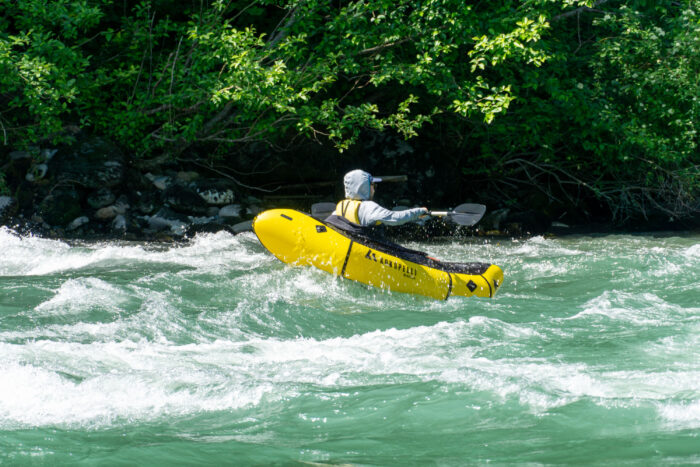
We’re not going to lie and say that packrafts handle great. They take some getting used to, and initially, they waggle a lot for most novice paddlers. But with some practice, the boats can paddle quite straight at decent speeds.
In general, the smaller ultralight boats will be the slowest. Self-bailers will be a little more sluggish both in speed and responsiveness than boats without holes in the floor. But a full boat — if you get swamped in waves — is much worse.
Boats that have a one-way valve for inflation allow for more pressure in the tubes. And this means better handling. The ability to get a tight boat is perhaps more important than any hull design feature.
Finally, boat handling is better if you fit well and are comfortable in the boat. Make sure you are getting a boat sized for you. Too small a boat, and you’ll sit lower in the water and be more cramped for longer paddles. In whitewater, a too-small boat capsizes more easily. Too big and it will be hard to effectively maneuver the boat, and you’ll spend a lot of extra energy to do so.
Some packrafts, like the Alpacka Raft Expedition or the Gnarwhal, are available in a number of different sizes, while the majority of rafts on the market are of the one-size-fits-most variety. These boats will often instead utilize an adjustable backband and seat setup to allow for some adjustability.
Still needing to take up some space at the end of your raft? Using a commercial brace like the Whitewater Foot Brace from Alpacka Raft can be an excellent way to take up some slack, though we’ve also seen paddlers using everything from yoga blocks to beach balls.

Rolled Size and Weight
The weight weenies among us like to count ounces, but in reality, choosing a packraft based on weight is a bad idea. Pick a boat that meets your paddling skills and use scenarios, and you’ll adapt to the size and weight.
Still, for more remote and lengthy use cases, pack size and weight are worth taking into consideration. With good technique, the roll size can be reduced significantly. And nearly all the single rafts we’ve used can be compressed enough to fit into a 40L pack (or lashed to bike handlebars) with plenty of room to spare.
If you are really concerned about weight, take the extra 10 minutes to dry it out. The weight difference between rolling a wet boat and a dry one can be up to several pounds!
Load Capacity
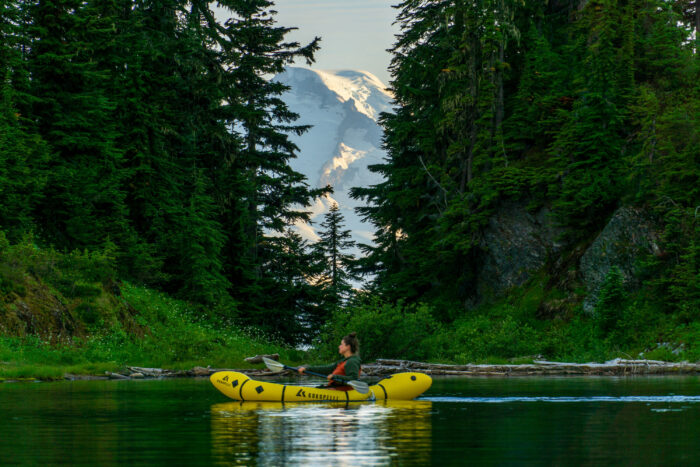
Pay attention to load capacity. If you get close to (or over) it, you will significantly affect performance. Most boats’ “maximum load” is the total weight limit of the paddler plus gear that will allow the boat to have good, consistent handling characteristics in ideal conditions.
Exceeding this does not mean the boat will sink. We’ve paddled the Alpacka Raft Scout (250-pound limit) with two adults plus gear (300+ pounds) in nonideal conditions so many times, we’ve lost count.
But, then again, we’ve also used a carbon fiber paddle to dig a snow cave on the upper slopes of Mt. Rainier, and it was pretty hard on the paddle. In short, the load capacity is a recommendation, and most boats are capable of at least floating more.
Durability

In general, packrafts are burly, but lighter boats are generally less durable. So, use a bit more caution with a packraft. If your boat is equipped with a TiZip, that is one of the easiest places to introduce leaks. So, make sure you learn how to care for it and keep it grit-free.
Less expensive boats (as noted in the “materials” sections) may be crafted from a PU fabric that is easier to tear, abrade, and delaminate than some of the more premium boats. We recommend sticking with the more established brands that have good customer service and pride themselves on craftsmanship.
Packraft Pro Tips
- Temper your boat: It should be nice and firm and will require at least one top-off after you get into the water. A more rigid boat paddles much better than a soft boat. And it is less likely to get leaks due to abrasion from rocks or contact with sharp sticks. Use care not to leave your boat in the sun once fully pressurized. This can cause damage and leaks due to overpressurization. Most manufacturers recommend a max inflation of 1.5-2.5 psi.
- Learn to field repair your boat: Most boats come with a small repair kit that can solve most leaks or minor damage within a few minutes. Small leaks are common with aggressive usage and are not a concern if you understand how to fix them. In addition to the repair kit, we carry a small bit of Tyvek tape (wound around a paddle shaft), which will take care of nearly every problem long enough to finish your trip and make a more permanent repair. For boats with a TiZip, one pro analogizes it to lip care: “I never use lip balm, and I come back from every trip with sore and chapped lips that take a week to heal. My wife is super diligent and never has that issue.” The cargo fly is the same. The zipper doesn’t heal when you don’t keep it lubricated. Light, frequent lubrication is the key!
- Slow down on the paddle strokes: Watch an expert paddle — they make it look effortless. Fewer strokes with deeper paddle penetration and smooth power is better than frantically slashing at the surface. Take the time to practice your strokes in more ideal settings so that they become automatic and easy. It will make a world of difference to your enjoyment as your missions increase in duration.

Price & Value
Packrafts certainly aren’t cheap, but rather should be looked at as any large recreation investment like a mountain bike or climbing rack: buy once — cry once. That said, there are bargains to be had even here, and if you’re willing to give up a bit in a few metrics, you can source a raft that’ll do everything you’re after. Consider how frequently you’ll paddle, where you’ll paddle, and how into this packrafting thing you want to get before doling out your hard-earned bills.
Budget
Budget packrafts can be had for less than $1,000, and it’s a good bet that they’ll be made from PVC compared to the TPU-coated nylon that more high-end boats use. These packrafts are often simpler in design, with bucket or self-bailing hulls that avoid the complexities (and cost) of adding a deck system. Weight is often the biggest tradeoff here, and while most of these boats are still backpackable, they won’t be the most enjoyable to ruck out into the wilderness with.
The $799 Kokopelli XPD is a great packraft at the price, and using a 1,000-denier PVC it’s also one of the toughest, making it a long-haul investment for not much of an actual investment. The 13-pound weight and larger packed size, however, relegates it to day trips for most of our paddlers. The Uncharted Supply Co Rapid Raft ($479) is another relative bargain, but does have a performance ceiling and is best suited to quick trips across rivers.
Mid-Tier
The universe of packrafts really opens up when jumping up in price to between $1,000 and $2,000, and the biggest shift is going to be in the material. TPU-coated nylon is stronger and lighter than PVC and is also far more packable, making these mid-tier packrafts much better at being carried into deep trips. These boats will also be more protective with enclosed whitewater deck and skirt systems and more nimble with optional thigh straps.
The Alpacka Raft Expedition ($1,725) is all of the above and more, and is a great balance of ability and packed size/weight. The Kokopelli Rogue R-Deck ($1,199) is another notable all-arounder for a good bit less, but lacks the integrated TiZip of the Expedition. For some, this won’t matter, but if you plan on doing overnight trips, do yourself a favor and get a boat with internal storage.
Premium
For around or north of $2,000, you can get into a true whitewater machine like the Alpacka Rafts Valkyrie ($2,350) or Kokopelli Rodeo ($2,000). Both of these packrafts are refined for big water paddling and aim to provide an experience as close to a hardshell boat as possible. This realm of packraft is for folks who are truly pushing out at the seams of packrafting, and you’ll certainly pay for the performance.
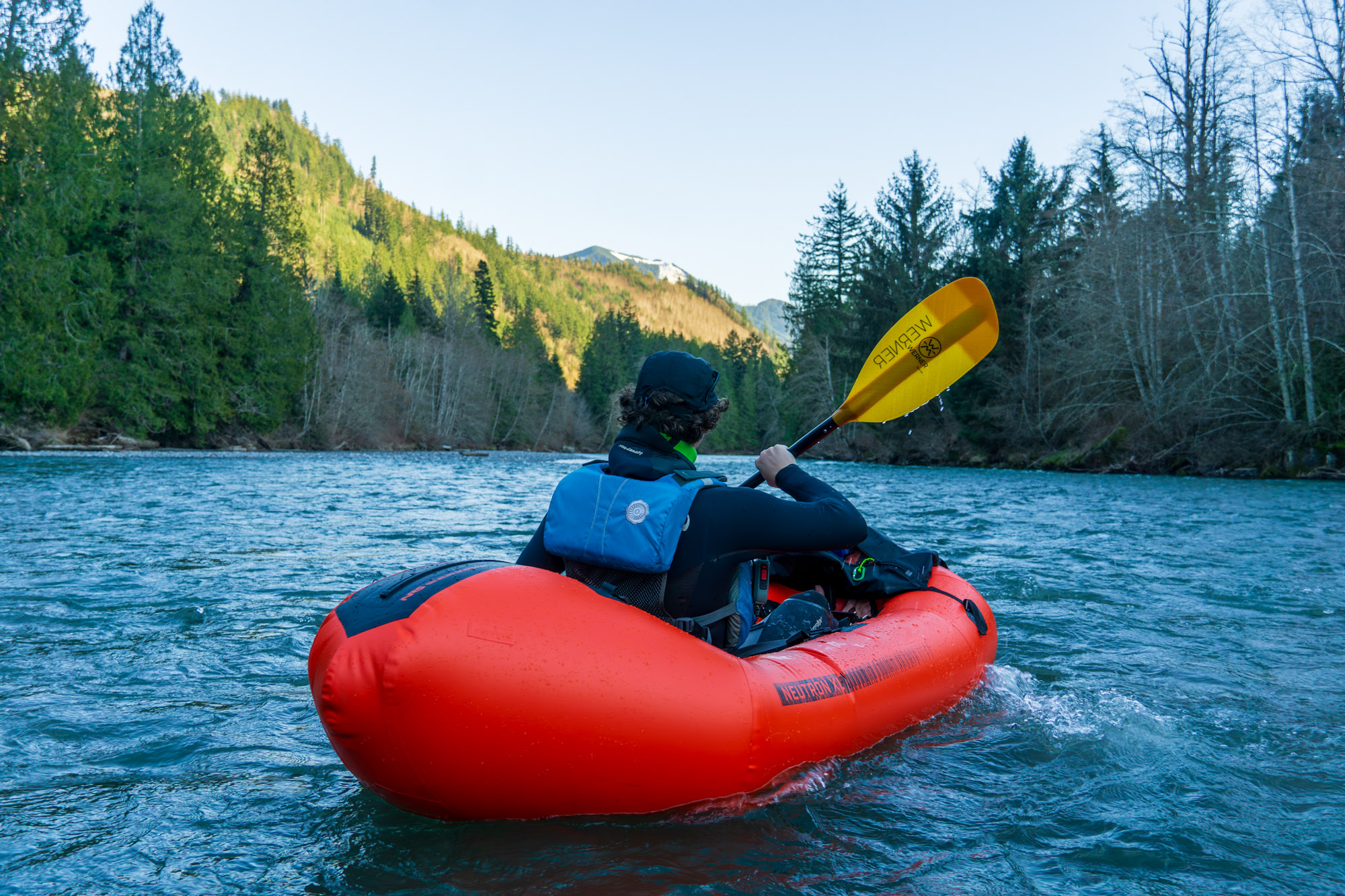
Frequently Asked Questions
Choosing a packraft boils down to where you land on the raft weight vs. ability scales. Because all packrafts should have some level of inherent packability, consider the types of places you’d like to go first when seeking out a packraft.
In general, there are three types of packrafts: Lightweight and packable, whitewater boats, and tandem packrafts. If alpine lakes and the occasional river crossing is your thing, check out a boat like the Uncharted Supply Co Rapid Raft, Alpacka Raft Ghost, or Scout.
If you’d like to up the ante and push into more turbulent waters, a capable whitewater boat like the Alpacka Raft Expedition or Kokopelli Recon will get you there. And if you’re looking to haul an extra person along, a boat like the Kokopelli Twain or Alpacka Raft Rendezvous fits the bill.
Most commercial packrafts will be made from TPU-coated nylon, which is a thermoplastic polyurethane-covered fabric that is tough, airtight, heat-sealable, and UV-resistant. Because this material can adhere to itself through heat, this allows manufacturers to create strong bonds without gluing or sewing.
There are some boats on the market, like the Kokopelli XPD, that use PVC, or polyvinyl chloride, as their main material. These fabrics are tough and can resist a hard day on the river, though they will pay for the durability in bulk and weight.
Watercraft paddles can be separated into two categories: those for use in low-angle, or high-angle paddling. Typical sea kayak paddles are built for low-angle paddling, where fatigue reduction is prioritized. These are often 200-220 cm long.
Whitewater paddles, on the other hand, are built for strong strokes, and often sport wide blades to better move water. These paddles are shorter, often in the 195-205 cm range. Most packrafters would be well suited with a whitewater paddle, though your packraft use will dictate your paddle choice.
You should sit with an athletic stance in a packraft, with your legs touching the end of the boat and your knees bent. Snug your backband up so that it supports you in place. Your seat should elevate you enough that you are in the proper paddling position.
A proper paddling position will allow you to better control your packraft, moving the boat around you and putting it on edge in the water.
Self-bailing packrafts incorporate holes in the floor of the raft that allows for water to pass through the boat once it enters the cockpit. These boats won’t have a whitewater deck, and will use a seat to keep paddlers up and out of the water as much as possible.
A self-bailer will be better for warmer water paddling, however, you’ll likely still want a drysuit, since the chance of getting wet is high.

The Best Inflatable Kayaks of 2025
Just inflate and go. We tested the best inflatable kayaks today, with capable and packable award winners from Advanced Elements, NRS, BOTE, and more.
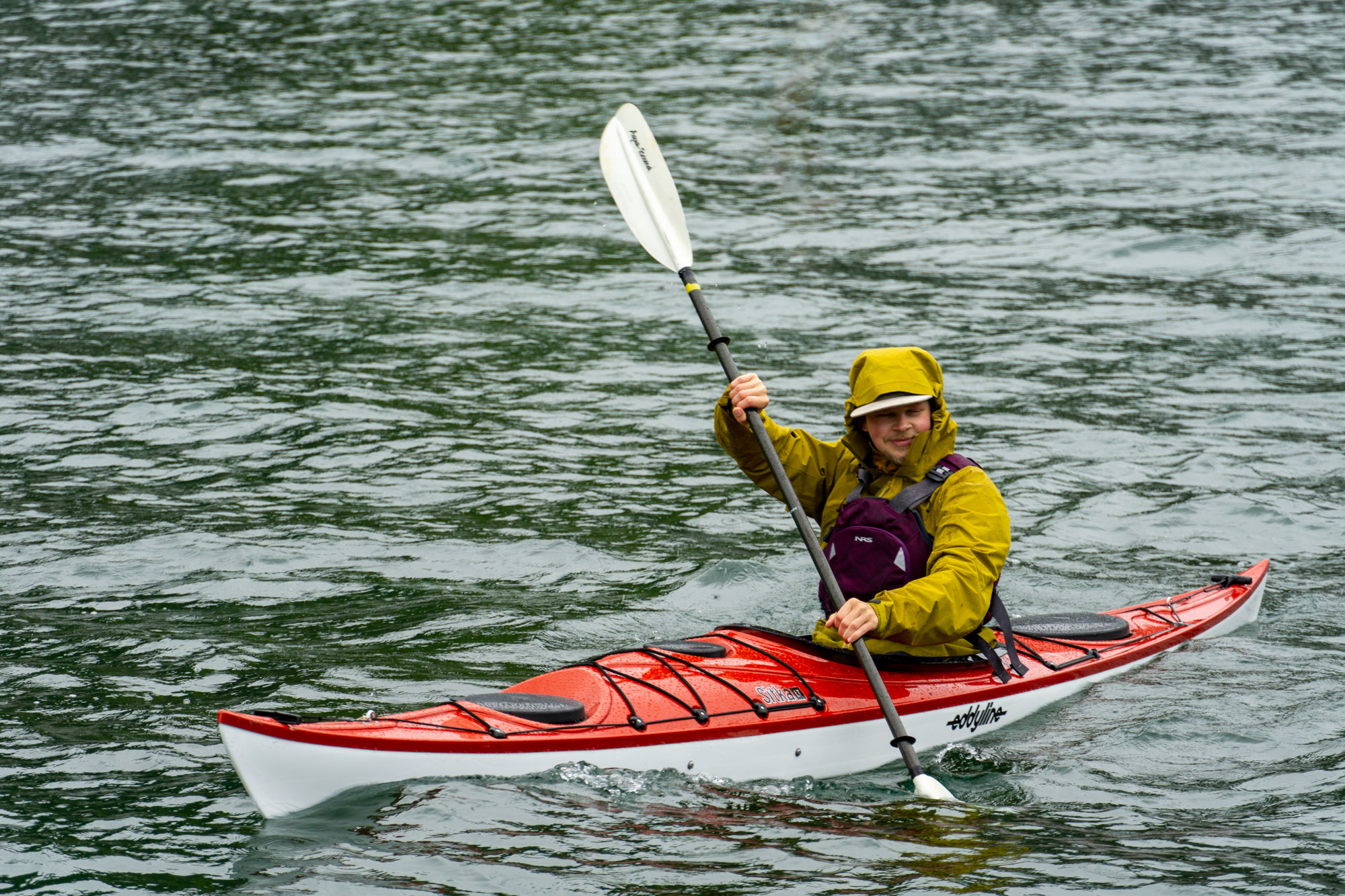
The Best Kayaks of 2025
Kayaks are the original all-terrain vehicles, and we tested the best from Old Town, Wilderness Systems, Eddyline, and more!
